Nature-rooted palettes and tactile materials are redefining comfort right now, turning an earthy living room into a soothing retreat that still feels fresh and current. Recent 2025 trend round-ups highlight warm neutrals—think cinnamon, sand, mushroom, and terracotta—layered with sustainable textures such as rattan, reclaimed wood, and linen to create rooms that look collected rather than styled Naomi Home. Designers are also championing biophilic touches—live plants, stone accents, and sunlight-hungry layouts—to support well-being and shrink ecological footprints ROWABI. With the right mix of color, texture, and responsible sourcing, these ideas invite you to craft a living area that feels as grounding as a quiet walk outdoors—let’s explore how.
1. Terracotta Accent Walls Warm the Earthy Living Room
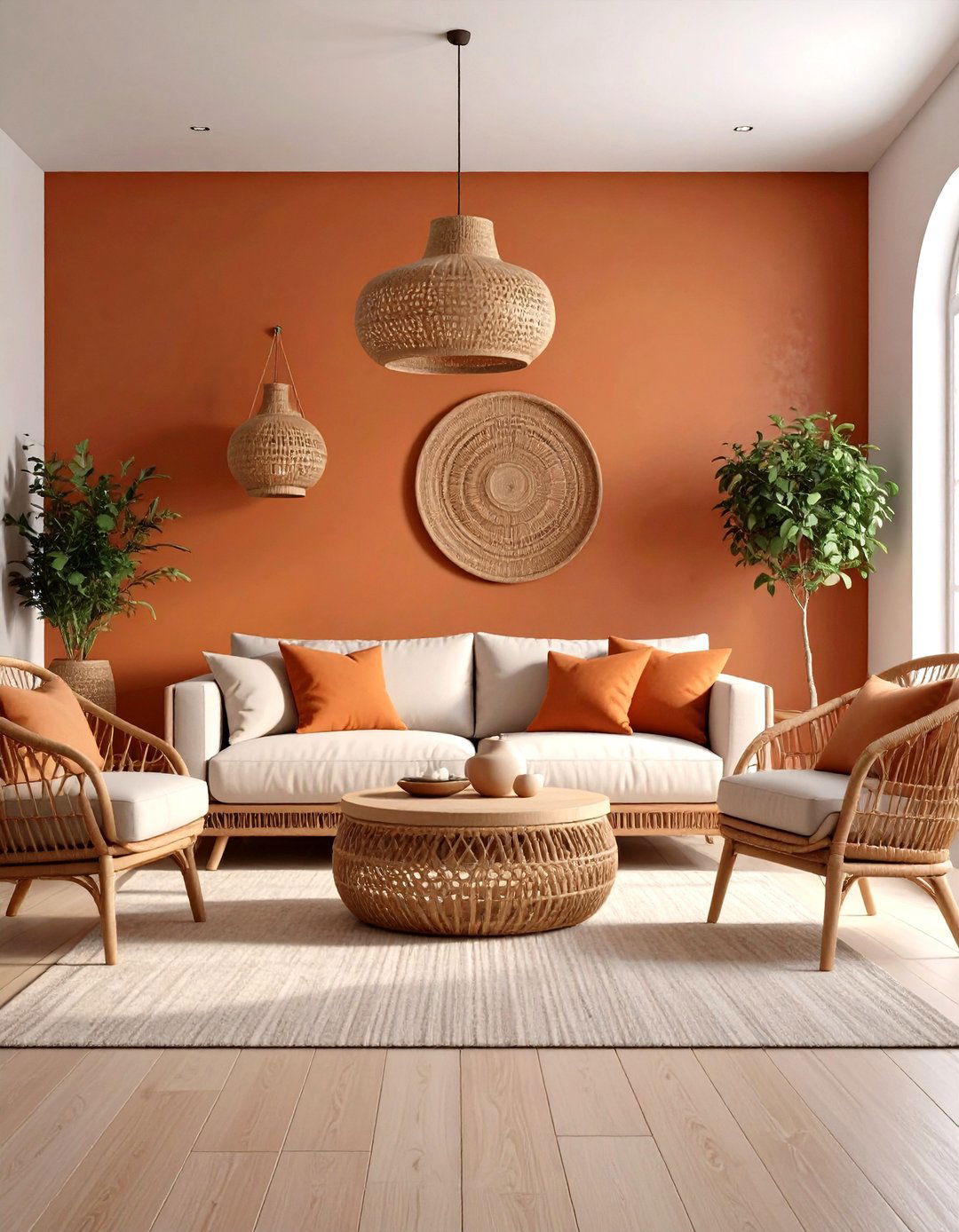
A single terracotta accent wall instantly bathes an earthy living room in sun-kissed warmth, echoing natural clay and desert canyons. Color forecasters say the rise of this grounded hue reflects a collective desire for interiors that feel nurturing and season-less Caring Real Estate Pinterest. Because terracotta sits between brown and orange on the spectrum, it pairs effortlessly with mushroom neutrals, olive textiles, and rattan furniture, giving you multiple styling lanes without repainting. Opt for a matte, low-VOC formula to keep the hue velvety and eco-friendly. If a full wall feels bold, start with a color-drenched niche or fireplace surround, then repeat the tone in small pottery to knit the palette together.
2. Reclaimed-Wood Coffee Tables Anchor the Space
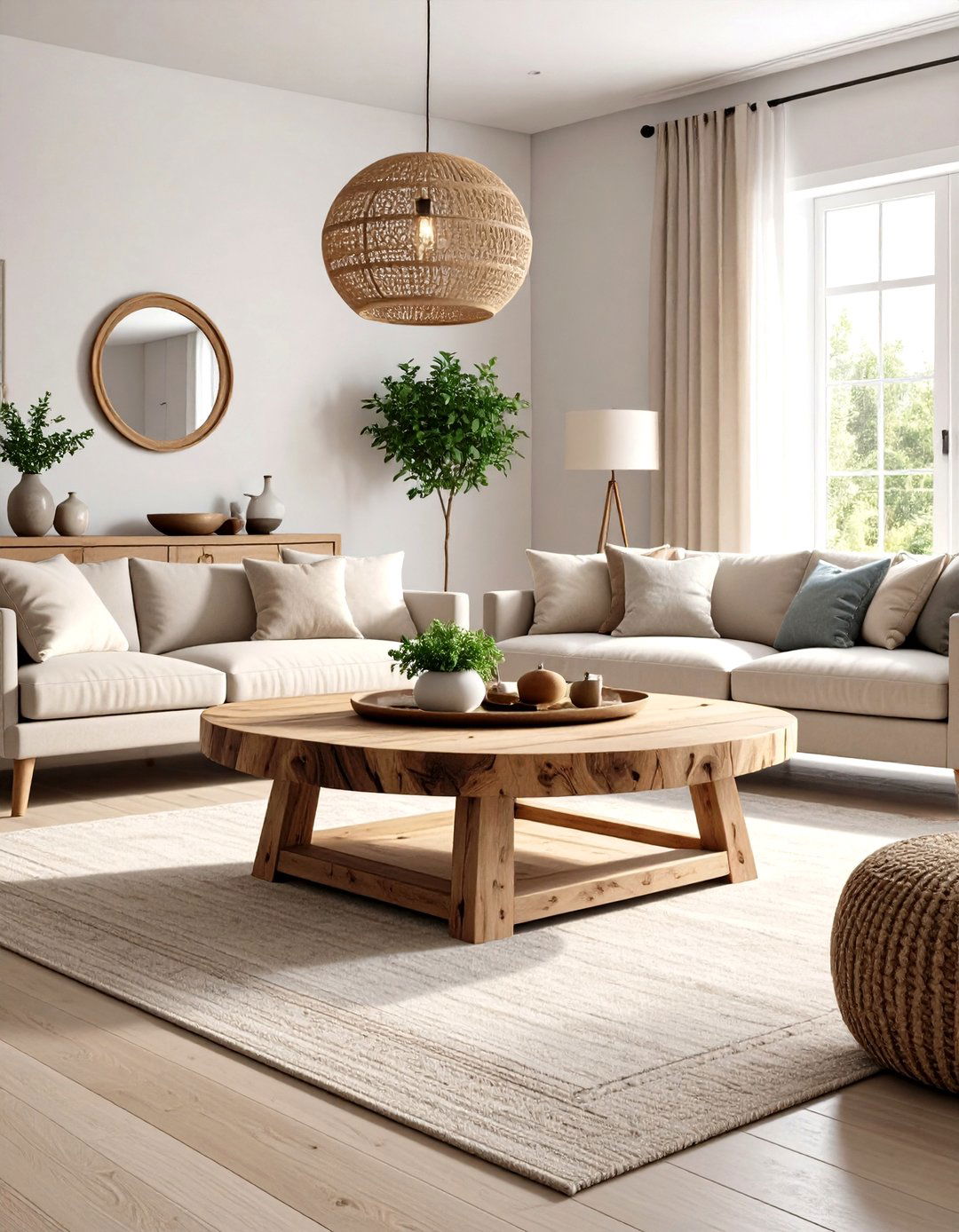
A reclaimed-wood coffee table delivers instant soul, showcasing weathered grain and knots that factory-fresh pieces can’t match. Reports on 2025 furniture trends reveal soaring demand for tables built from salvaged floorboards and retired beams, chosen for their carbon-saving credentials as much as their patina BuyBestChest OJ Commerce. The rougher surface highlights every mug, linen coaster, or hand-thrown bowl you place on top, adding tactile depth to an earthy living room. Keep finishes natural—just a light beeswax rub—to let the timber’s history shine through. Balance the heft with airy metal legs or a woven seagrass tray, preventing the piece from feeling visually heavy while anchoring the seating area.
3. Jute Rugs Add Organic Texture Underfoot

Soft yet nubby, a natural jute rug grounds an earthy living room like a patch of dried meadow grass beneath bare feet. Jute earns high marks for sustainability, rapid renewability, and surprisingly low maintenance—its natural oils repel dust better than many synthetics, making it friendlier for allergies and easy to vacuum Jaipur Rugs. Because the fiber’s warm buff color hides everyday wear, you can confidently choose a generous size that lets all major seating legs rest on the rug, visually tying the zone together. Layer a smaller wool Kilim on top when you crave seasonal pattern, then swap it out in summer for breezier, sand-hued simplicity.
4. Linen Sofas for Breathable Earthy Comfort
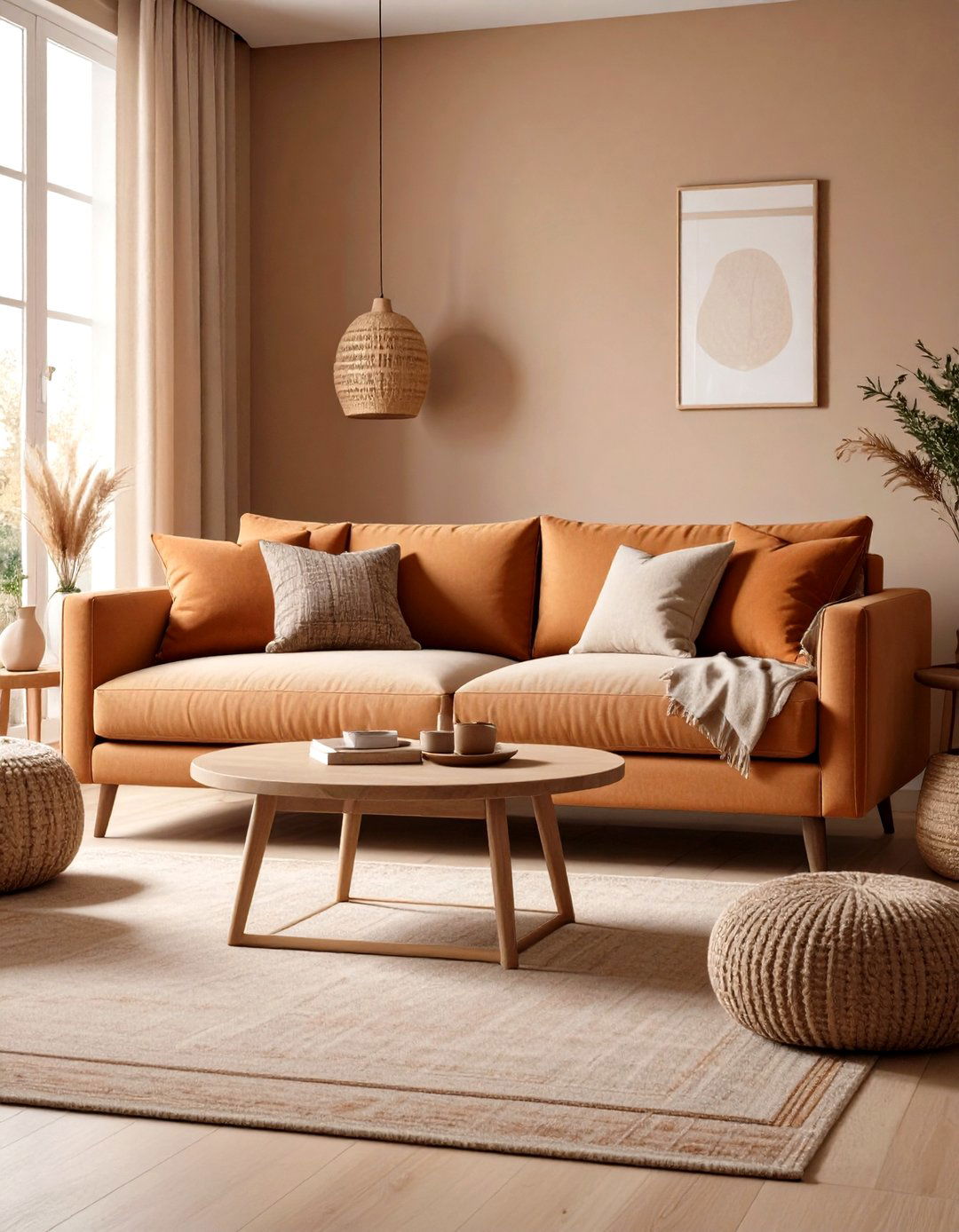
A linen-upholstered sofa slips seamlessly into any earthy living room, its natural slub and breathable weave keeping seating cool in heat and cozy in cooler months. Interior reports list linen alongside wool and bouclé as the tactile fabrics clients request most in 2025, prized for their relaxed silhouettes and sculptural softness Homes & Gardens Architectural Digest. Linen’s muted, chalky finish also takes earthy dyes beautifully—try clay, oat, or deep olive—without feeling flat. Protect cushions with removable, machine-washable covers or a loose slipcover, extending lifespan in family settings. Finish with tonal cushions in hemp or cotton for a layered, effortless palette that can be refreshed seasonally.
5. Indoor Greenery and Biophilic Layouts
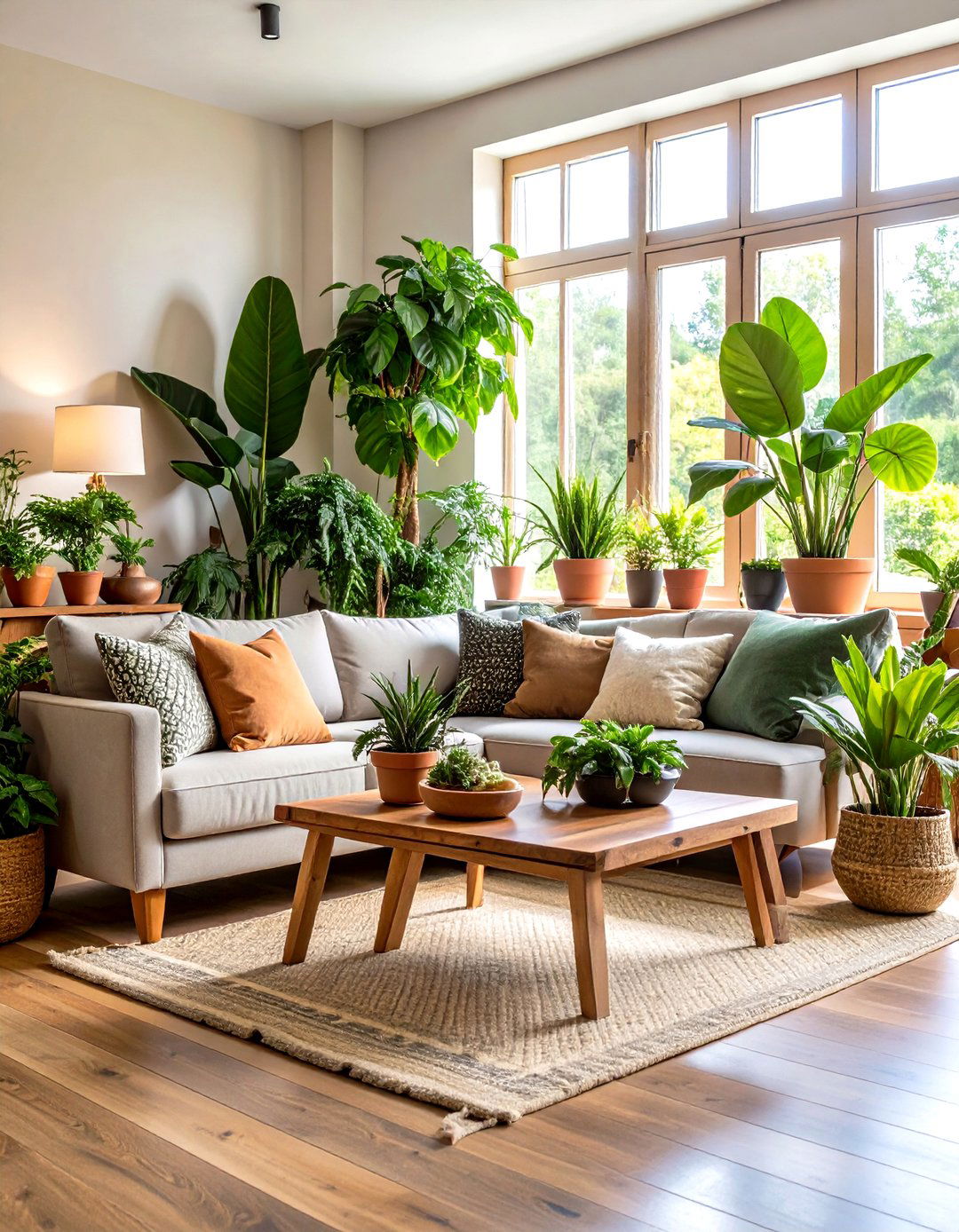
Bringing real plants into an earthy living room does more than beautify; biophilic design research links greenery to reduced stress and better indoor air quality ROWABI. Position low-maintenance species—snake plants, pothos, or dwarf olives—near windows where filtered light mimics forest understories. Place tall specimens behind the sofa to soften corners, while trailing vines on floating shelves emphasize verticality. Group clay pots on a reclaimed bench to create a mini indoor garden and use saucers or cork pads to protect timber floors. The living foliage reinforces the room’s earth-first ethos while introducing natural movement and seasonal change.
6. Hand-Thrown Ceramics Celebrate Wabi-Sabi Charm
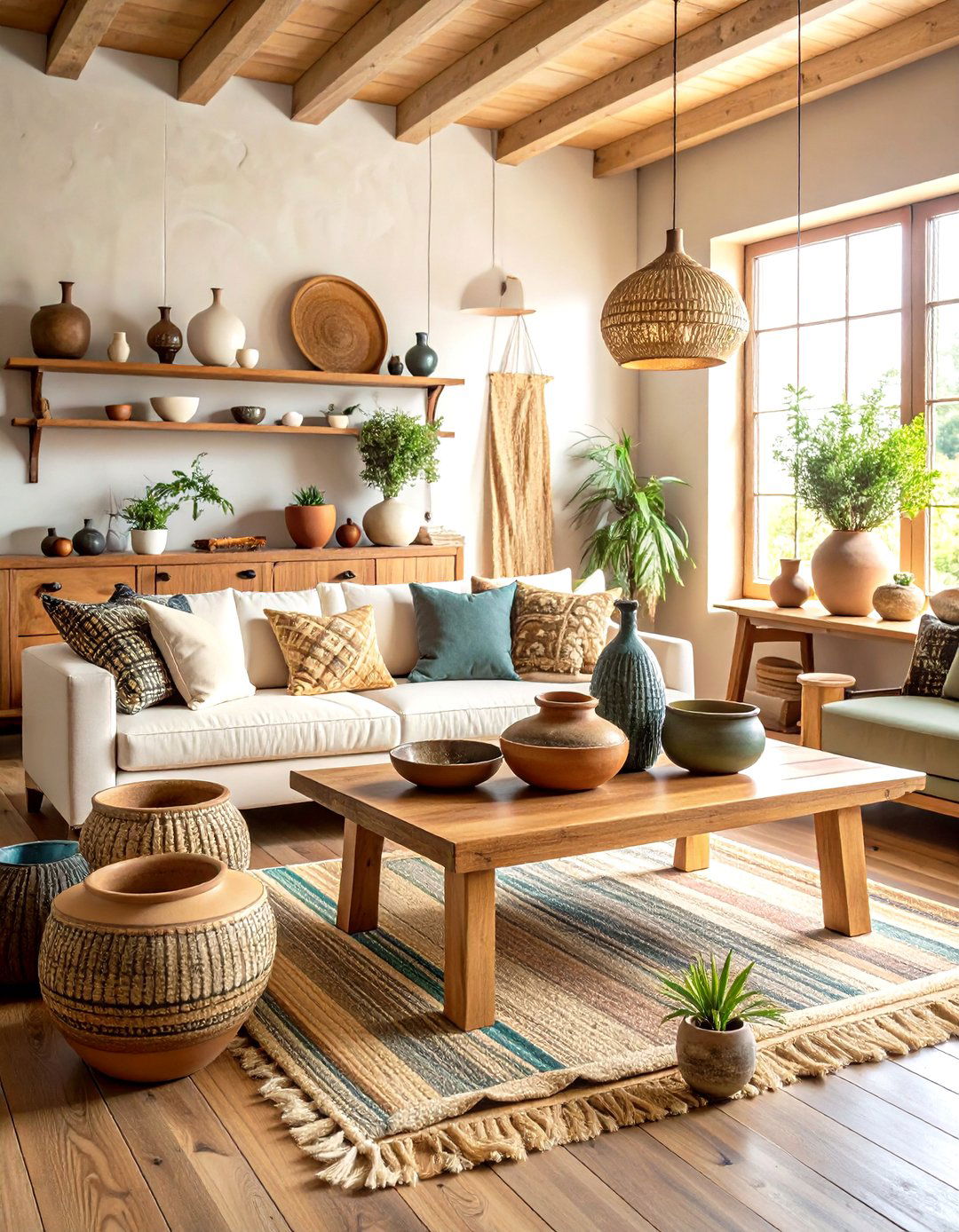
Wabi-sabi decor champions imperfection, and hand-thrown ceramics embody this philosophy with ridged rims, glaze drips, and asymmetrical silhouettes that feel grounded and human. Inspiration boards brimming with wabi-sabi living rooms underscore how a few clay vessels can shift the mood from polished to poetic Pinterest Pinterest. Cluster varying heights on the mantel or coffee table, filling larger pieces with dried seed heads or foraged twigs to echo outdoor textures. The muted, earthy glazes—think charcoal, sand, umber—harmonize with terracotta walls and linen upholstery, reinforcing an aesthetic of quiet authenticity.
7. Soft Greige Backdrop Lets Nature’s Hues Shine
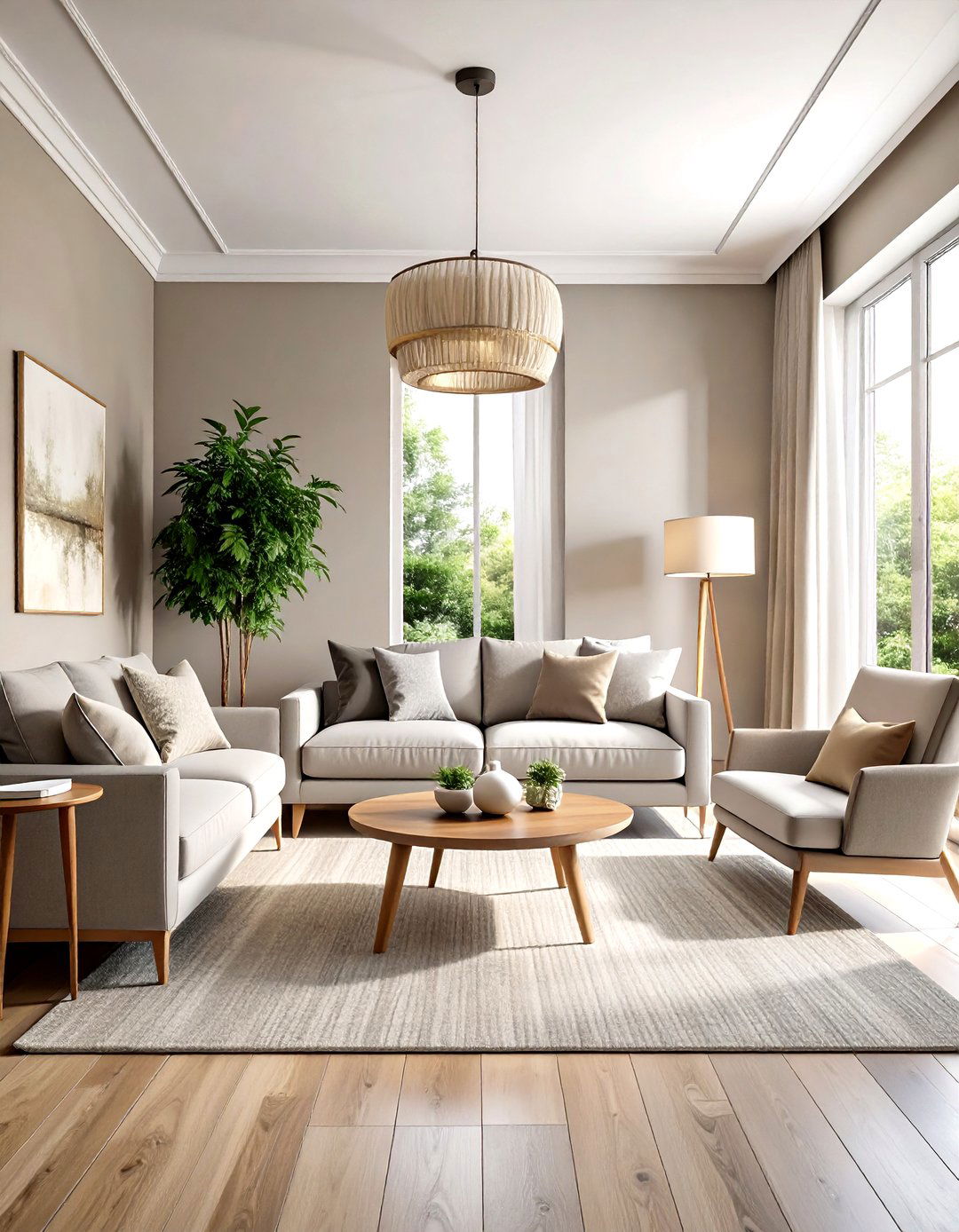
When bolder accents carry the storytelling, walls in soft greige or warm white set a breathable stage. Color experts flag adaptable neutrals such as understated greige and whisper-green as top “go-with-anything” choices that stand the test of shifting decor Real Simple. In an earthy living room, these hues reflect daylight gently, preventing spaces from skewing too dark when you add weightier materials like leather or wood. Aim for an eggshell finish to diffuse light yet remain easy to wipe clean. Once the base is dry, add depth through art, cushions, or foliage, confident that the background will harmonize rather than compete.
8. Sage and Terracotta Pairing for Balanced Warmth
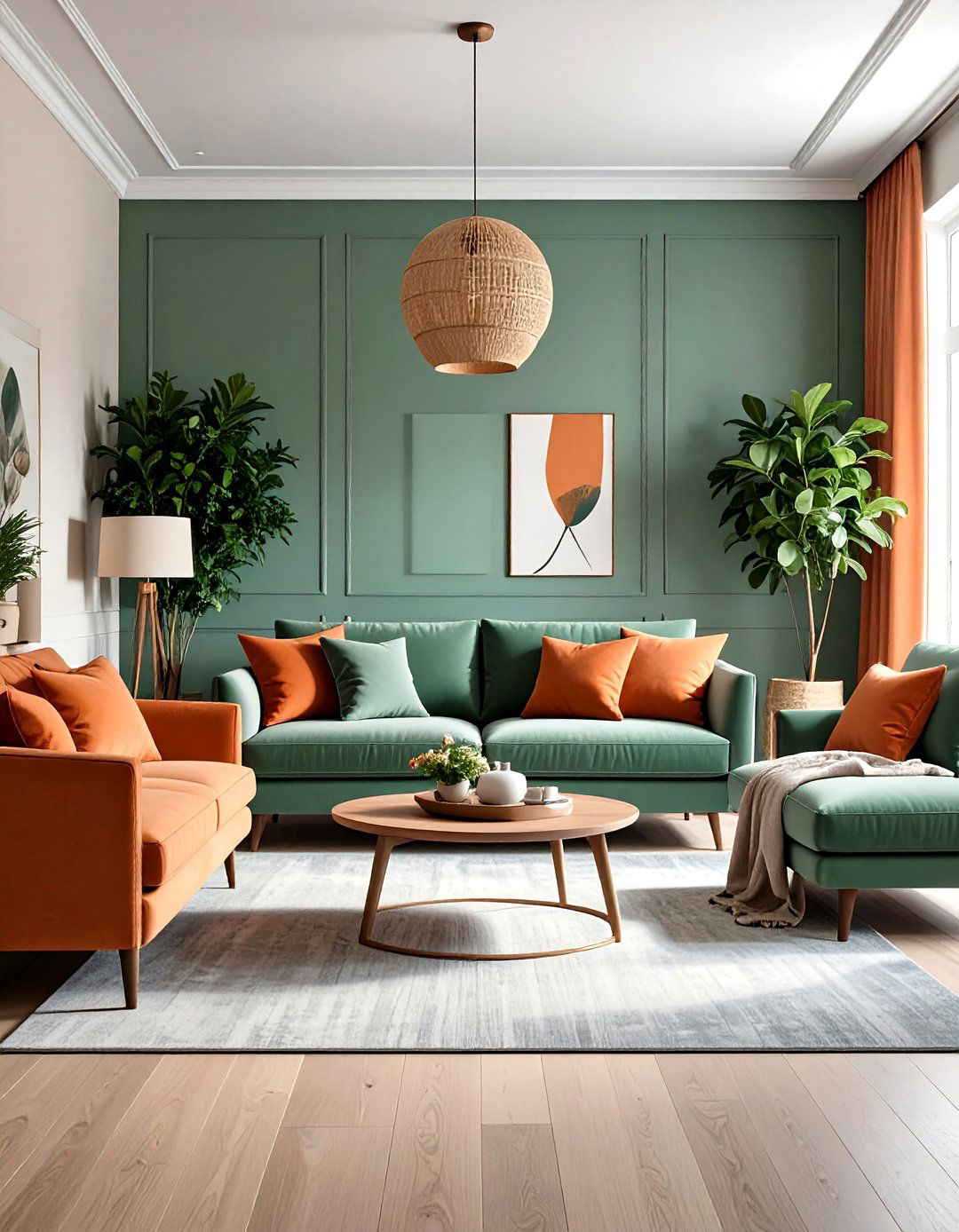
Sage green’s crispness tempers terracotta’s warmth, producing a palette that feels both fresh and grounded. Design influencers point to this duo as one of 2025’s most versatile earthy combinations, praising its subtle boho flair and compatibility with cream accents Pinterest. Use sage for large upholstery or a vintage rug, while terracotta shines in accent chairs or wall niches. Repeat each hue at least three times around the room—perhaps a plant pot, pillow, and art print—to create visual rhythm. The complementary contrast enlivens the space without sacrificing its calm, natural character.
9. Stone Accessories Ground the Palette
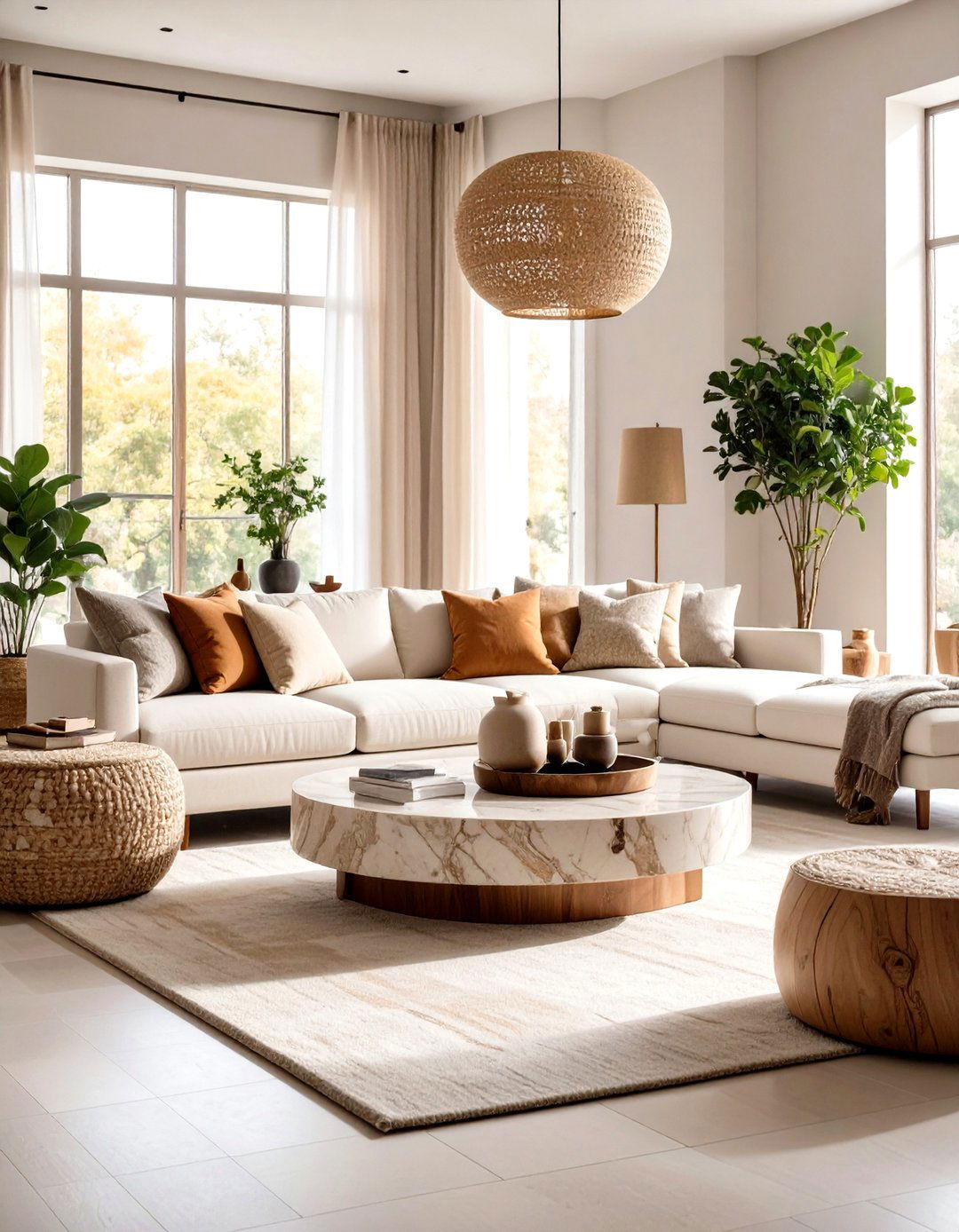
From marble coasters to alabaster lamps, stone accents lend an earthy living room literal heft and a cooling counterpoint to soft textiles. Furniture forecasts indicate rising demand for natural stone coffee tables and décor objects that showcase organic veining and unique mineral patterns OJ Commerce. Even a small travertine side table brings tactile interest and echoes outdoor geology. Keep finishes honed rather than glossy to maintain a raw, grounded feel. Pair stone with woven baskets or rough timber to highlight contrasting textures, ensuring the vignette reads curated rather than showroom-perfect.
10. Layered Leather and Wool Throws for Tactile Depth
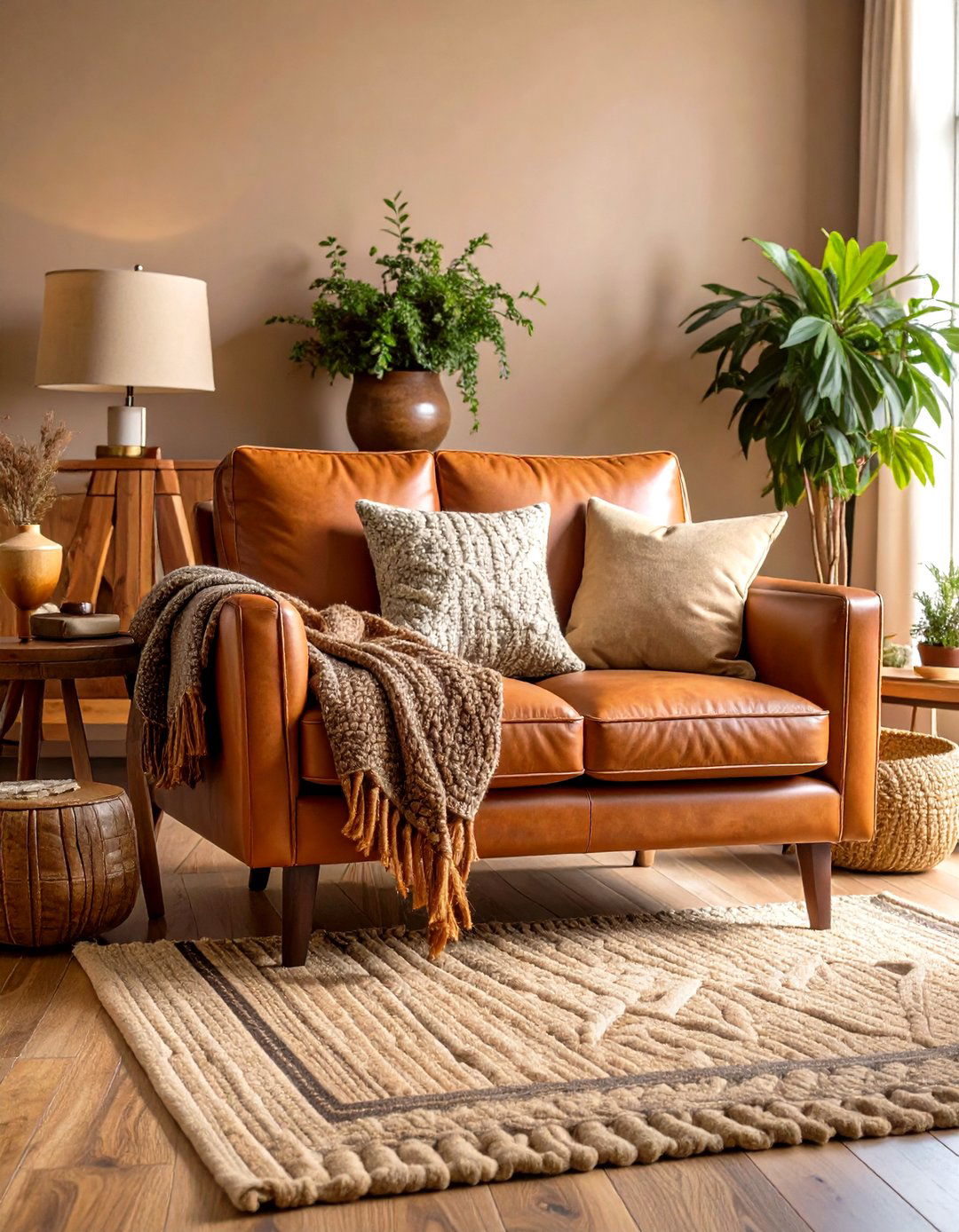
Nothing invites an evening unwind quite like tossing a wool throw over a well-worn leather armchair. Designers emphasize tactile layering—combining smooth hides, chunky knits, and brushed cotton—to amplify sensory comfort in 2025 living rooms Architectural Digest. Earth-tone leather (camel, chocolate, cognac) gains character over time, while wool brings breathable warmth and subtle lanolin sheen. Drape a fringed blanket diagonally across the sofa back, then fold a lighter linen throw below for summer months. Vary weights and weaves so the room responds to shifting seasons yet maintains its nature-inspired narrative.
11. Rattan or Bamboo Light Fixtures as Natural Statement

Ceiling pendants woven from rattan or bamboo cast dappled patterns reminiscent of forest light, underscoring an earthy living room’s connection to nature. Trend analyses name these fibers regulars in 2025 interiors, appreciated for their renewable harvest cycles and subtle coastal-meets-bohemian vibe Naomi Home. Choose oversized shades to balance lower, solid furniture forms—think a 60 cm basket pendant above the coffee table—so the fixture becomes sculpture as well as illumination. For evening ambience, install a dimmer and swap harsh bulbs for warm 2700 K LEDs that complement the fixture’s honeyed tones.
12. Maximizing Daylight with Bare Windows and Sheers
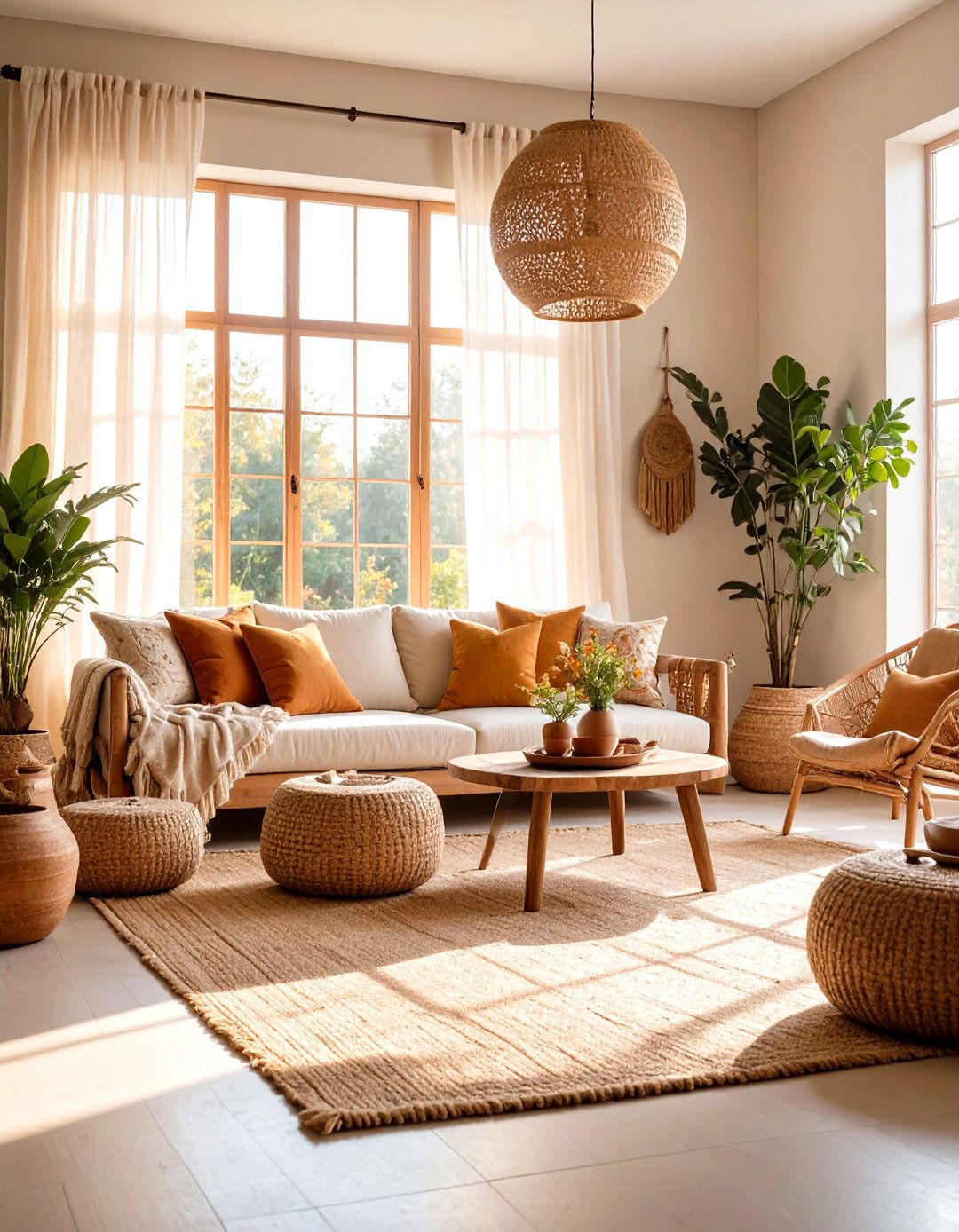
Natural light is the most cost-effective mood booster, and biophilic principles encourage unfiltered views whenever privacy allows ROWABI. Trade heavy drapes for gauzy linen sheers or leave high clerestory windows uncovered, letting sunlight play across jute rugs and terracotta pots throughout the day. If street-level glazing needs screening, opt for bamboo shades you can roll clear in daylight hours. The strategy reduces reliance on artificial lighting and highlights every earthy material choice, from stone side tables to weathered oak shelves, as light shifts.
13. Clay Planters as Sculptural Accents
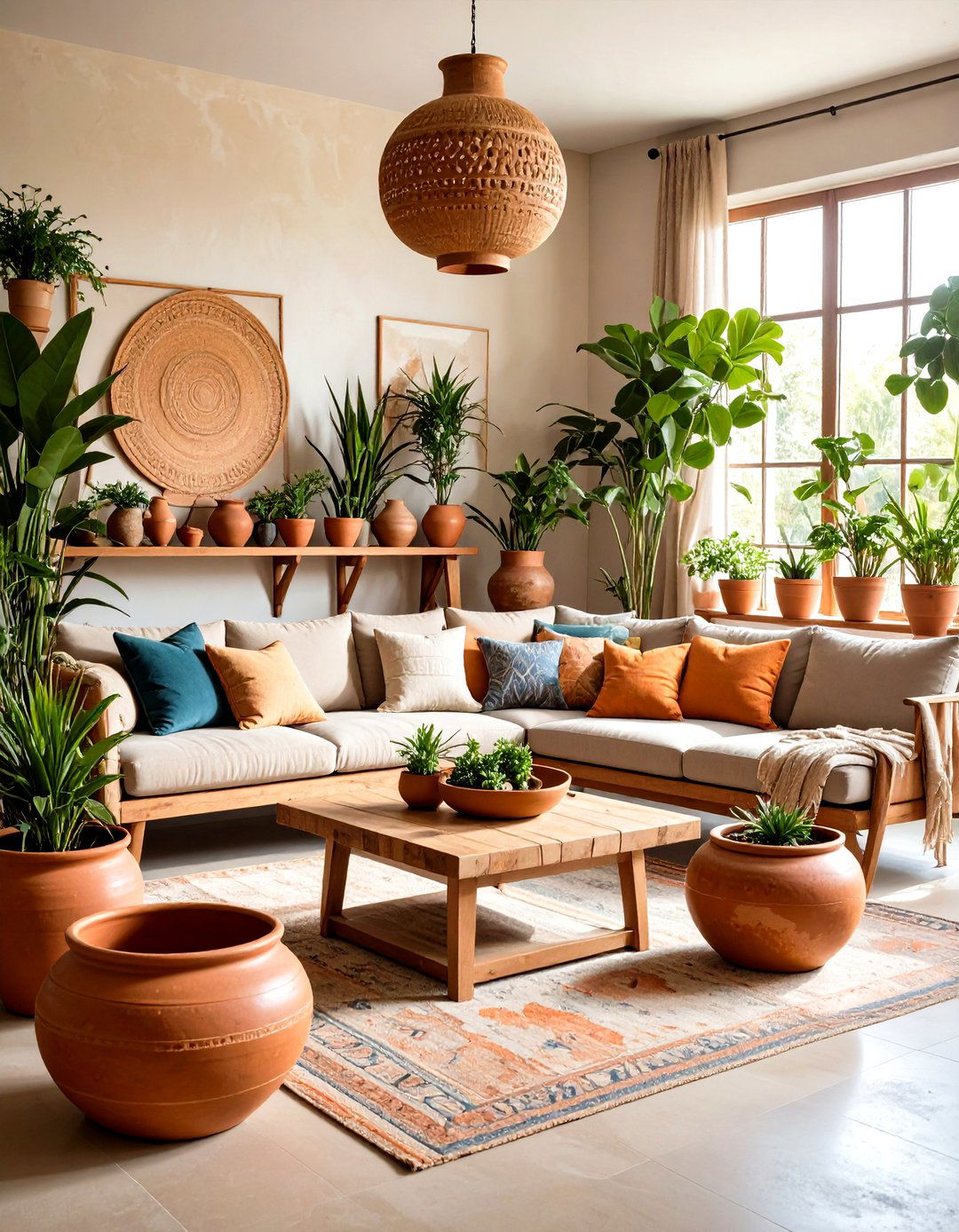
Hand-molded clay planters marry form and function, providing breathable homes for plants and delivering sculptural lines to an earthy living room. Inspiration galleries show terracotta pots in varying diameters lined along hearths or grouped on low stools for a collected effect Pinterest. Because clay wicks moisture, roots stay healthier, and the pot itself slowly develops a chalky patina that enhances authenticity. Mix silhouettes—tall cylinders, squat bowls, textured ridges—to add rhythm. A final coat of natural beeswax can deepen color and guard against stains without erasing those subtle surface blushes.
14. Earth-Inspired Artwork Frames the Narrative

Landscape photographs, abstract mineral prints, or pressed botanical studies reinforce your earthy living room story while personalizing blank walls. Biophilic-design advocates note that even two-dimensional nature references can foster calm and mental restoration, especially in urban settings ROWABI. Keep frames in unfinished oak or blackened steel to echo other raw materials in the room. Consider one oversized piece above the sofa for drama or a grid of smaller works to mimic gallery rhythm. Whichever route you choose, let colors draw from the room—sage foliage, terracotta soil, shale greys—so the art functions like an exterior window.
15. Curved, Organic-Shaped Furniture Echoes Landscapes
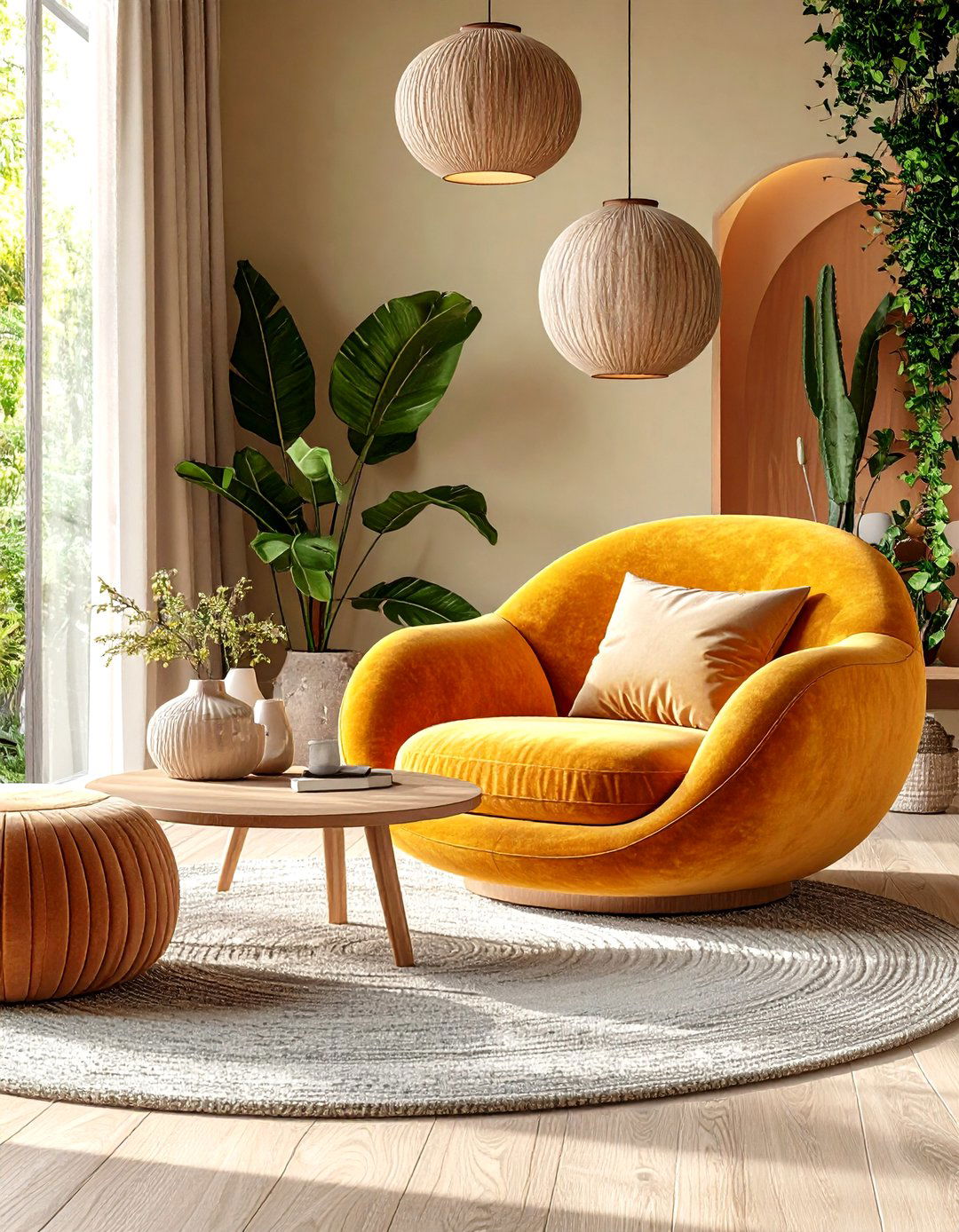
Furniture designers are softening silhouettes, embracing sweeping curves and pebble-like profiles that mirror natural landforms. 2025 sofa and chair forecasts highlight sculptural shapes as top trends, citing their ability to make living rooms feel welcoming and contemporary without sacrificing comfort Homes & Gardens. In an earthy living room, these pieces offset the rectilinear lines of fireplaces and bookcases. Pair a rounded boucle armchair with a live-edge stump side table to reinforce organic flow. Keep upholstery in muted earth tones so the form, not color, steals the spotlight, and allow at least 75 cm clearance around the chair to showcase its silhouette.
16. Bouclé and Nubby Cushions for Subtle Earthy Texture

Bouclé has moved from fashion runways to living rooms, bringing looped softness that invites touch. Designers listing 2025 favorites mention bouclé cushions and ottomans as easy upgrades that transform a sofa’s feel without large-ticket spending Architectural Digest. Choose undyed wool or muted taupe bouclé to maintain an earthy palette, then mix with flat-weave hemp pillows for contrast. Limiting cushions to three or five keeps the arrangement intentional; vary sizes so the eye travels. Because bouclé’s loops can snag, stick to zip-off covers you can gently hand-wash, preserving plushness and color integrity.
17. Unlacquered Brass or Aged Metal Details Provide Warm Patina
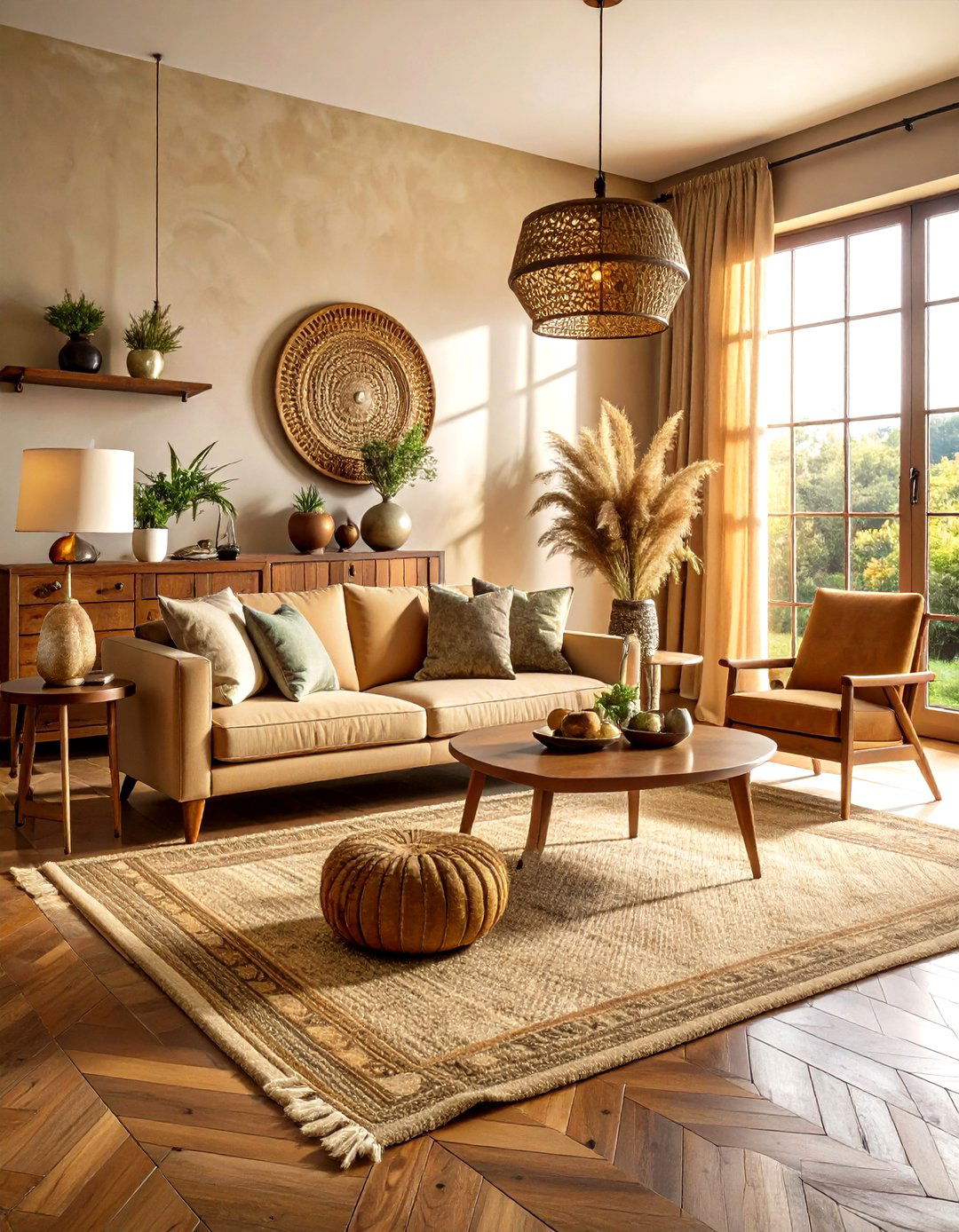
Metal accents don’t have to read sterile. Unlacquered brass, aged bronze, or lightly weathered iron bring quietly gleaming warmth that deepens over time. Interior reports note a shift from polished chrome toward metals that gather patina, aligning with the earthy living room’s embrace of imperfection Architectural Digest. Swap existing hardware—cabinet pulls, lamp bases, or picture frames—for raw brass versions. As oxygen dulls the surface, hues move from bright gold to mellow honey, echoing autumn leaves and clay tiles. If you prefer a controlled aging process, apply natural beeswax to slow oxidation while retaining that soft glow.
18. Upcycled and Vintage Pieces for Sustainable Character
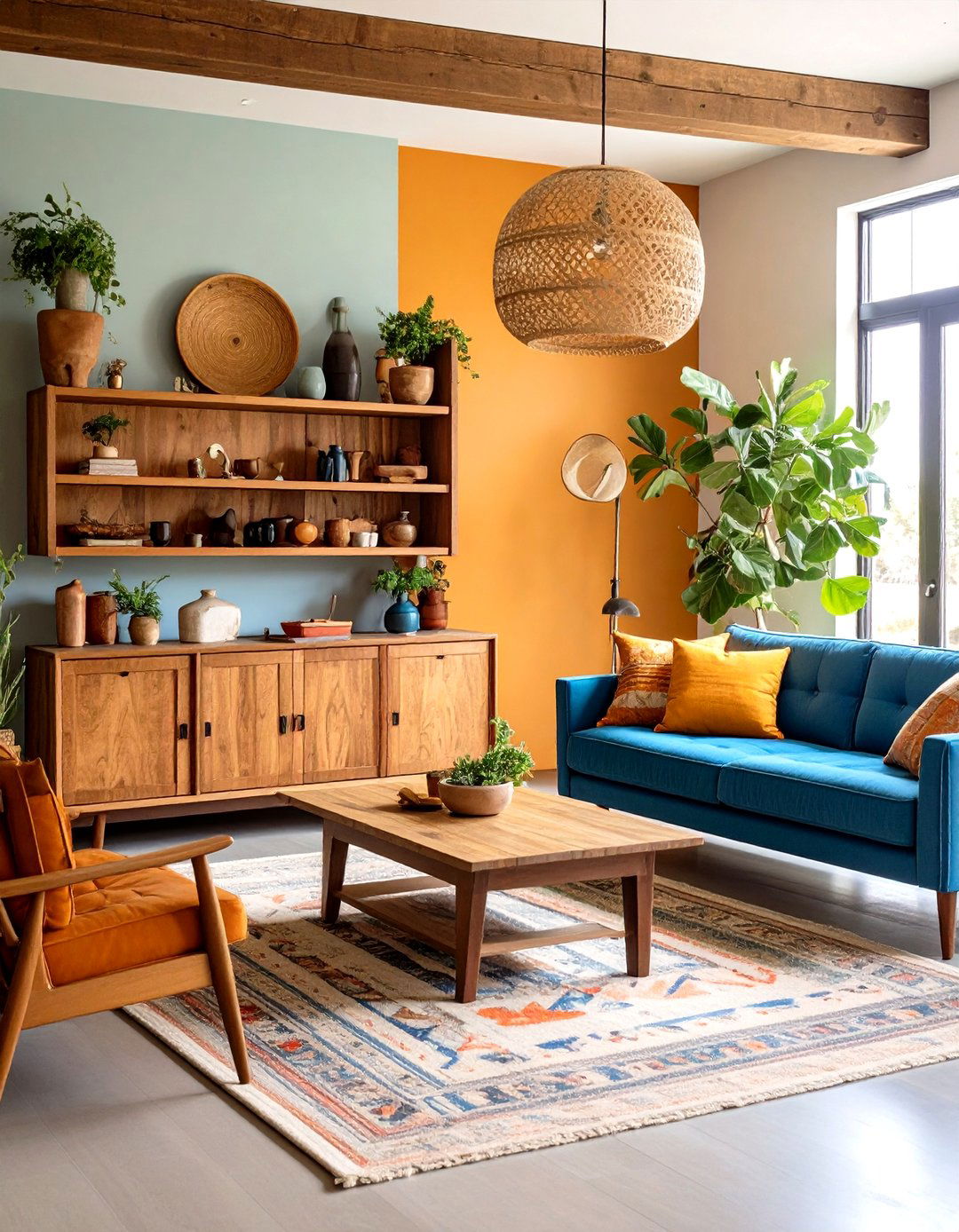
Sustainability remains a driver in 2025 interiors, with many homeowners sourcing vintage or upcycled décor to cut waste and add one-of-a-kind authenticity BuyBestChest OJ Commerce. Hunt flea markets for mid-century teak credenzas or turn salvaged barn beams into floating shelves; these storied items dovetail beautifully with other earthy materials. When mixing eras, keep the palette cohesive—walnut, terracotta, olive—so the room feels intentional rather than chaotic. A quick sand and natural oil finish can revive tired wood while preserving imperfections that whisper of past lives.
19. Pet-Friendly Wool or Jute Rugs Maintain Practicality
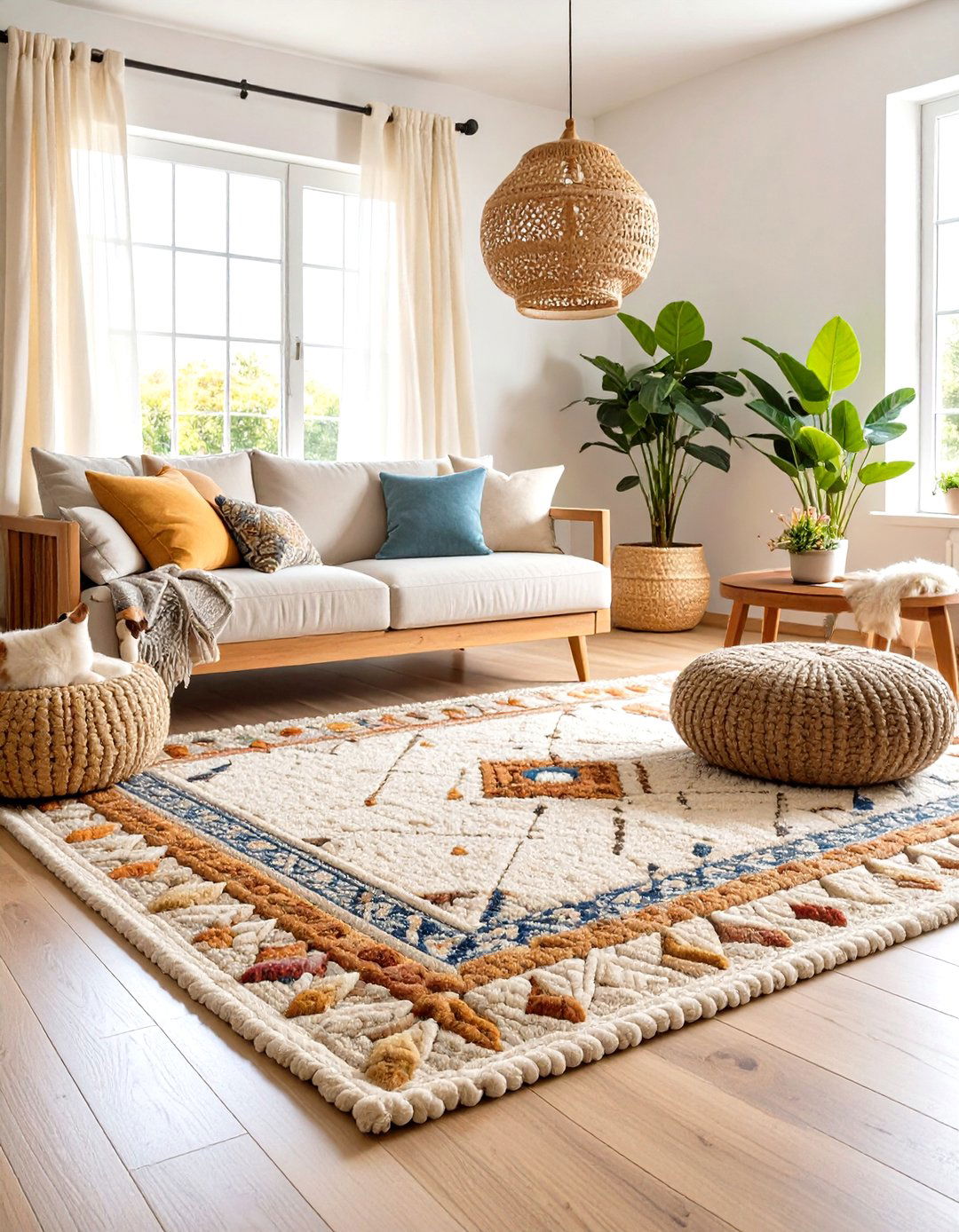
For households sharing their earthy living room with furry friends, rug choice must balance beauty and resilience. Pet-care experts favor hand-knotted wool or tightly woven jute for durability, breathability, and easier cleaning compared to synthetic alternatives, recommending mid-tone shades that disguise shedding Livingetc. Position a low-pile wool rug in high-traffic areas, saving loftier shags for spots your pets seldom frequent. Blot spills quickly with diluted vinegar and water; natural fibers respond well and avoid trapping odors. The result is a floor covering as responsible as it is rustic.
20. Jewel-Tone Accent Pieces Add Earth-Rich Contrast

Deep plums, berry reds, and teal accents enrich an earthy living room much like mineral veins through rock strata, offering contrast without veering into high-gloss territory. Seasonal palette predictions suggest punctuating warm neutrals with saturated jewel notes to prevent monotony and reflect a sense of personality. Introduce the hues through velvet cushions, a vintage kilim pouf, or a ceramic lamp base so they remain accents, not the main story. By repeating a chosen jewel color in at least three spots—perhaps art, textiles, and florals—you create deliberate cohesion while keeping the core palette grounded.
Conclusion:
An earthy living room hinges on honest materials, grounded hues, and sustainability—but that doesn’t mean sacrificing modern flair. From terracotta walls and reclaimed tables to biophilic greenery, each idea above layers texture, wellness, and character while lowering environmental impact. Mixing raw wood, breathable fabrics, and softly patinated metals cultivates warmth; punctuating with sage, clay, or jewel tones keeps the palette lively. Whether you adopt a single concept or weave several together, the result is a space that feels calm, authentic, and deeply connected to the natural world—an invitation to slow down and settle in.


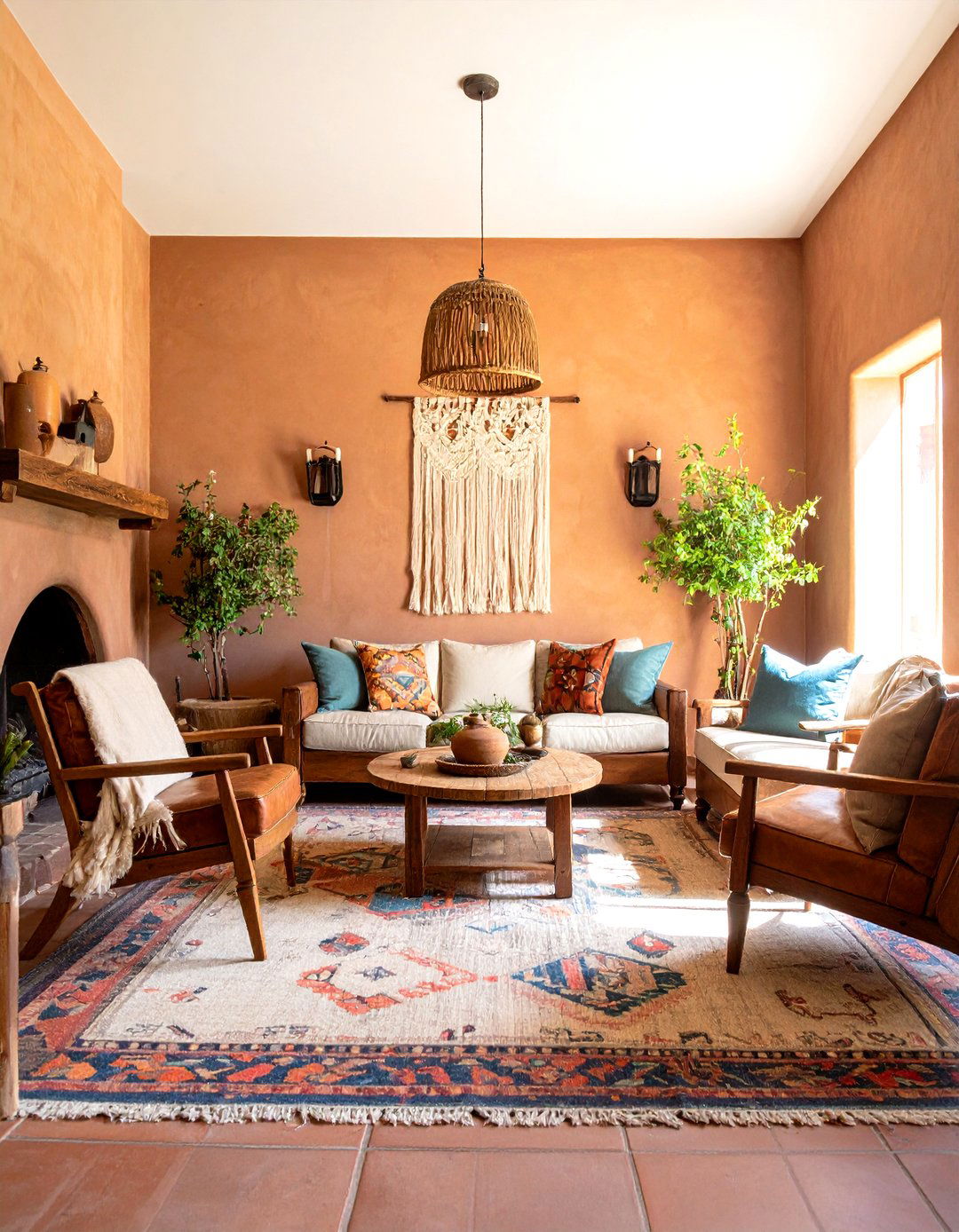
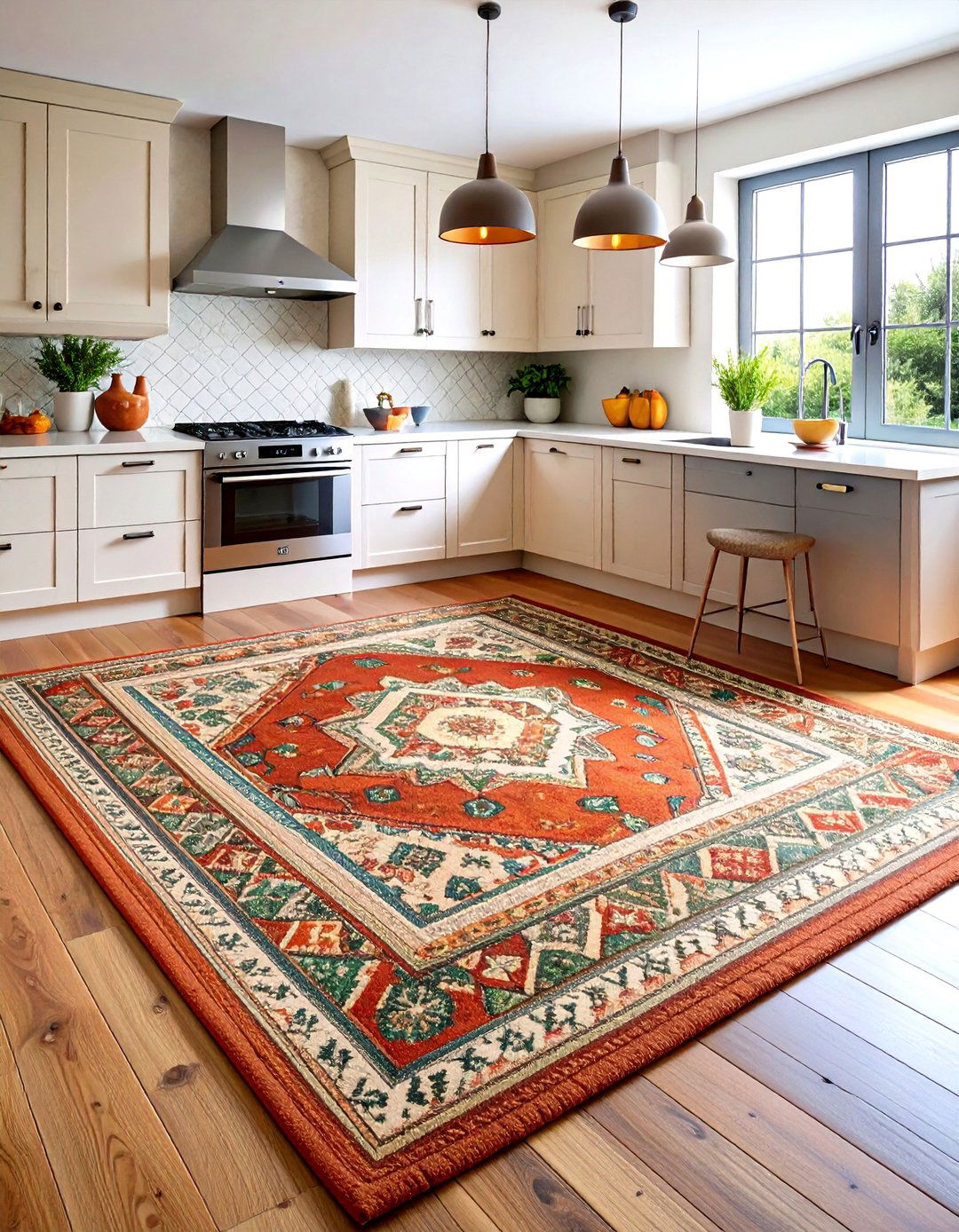
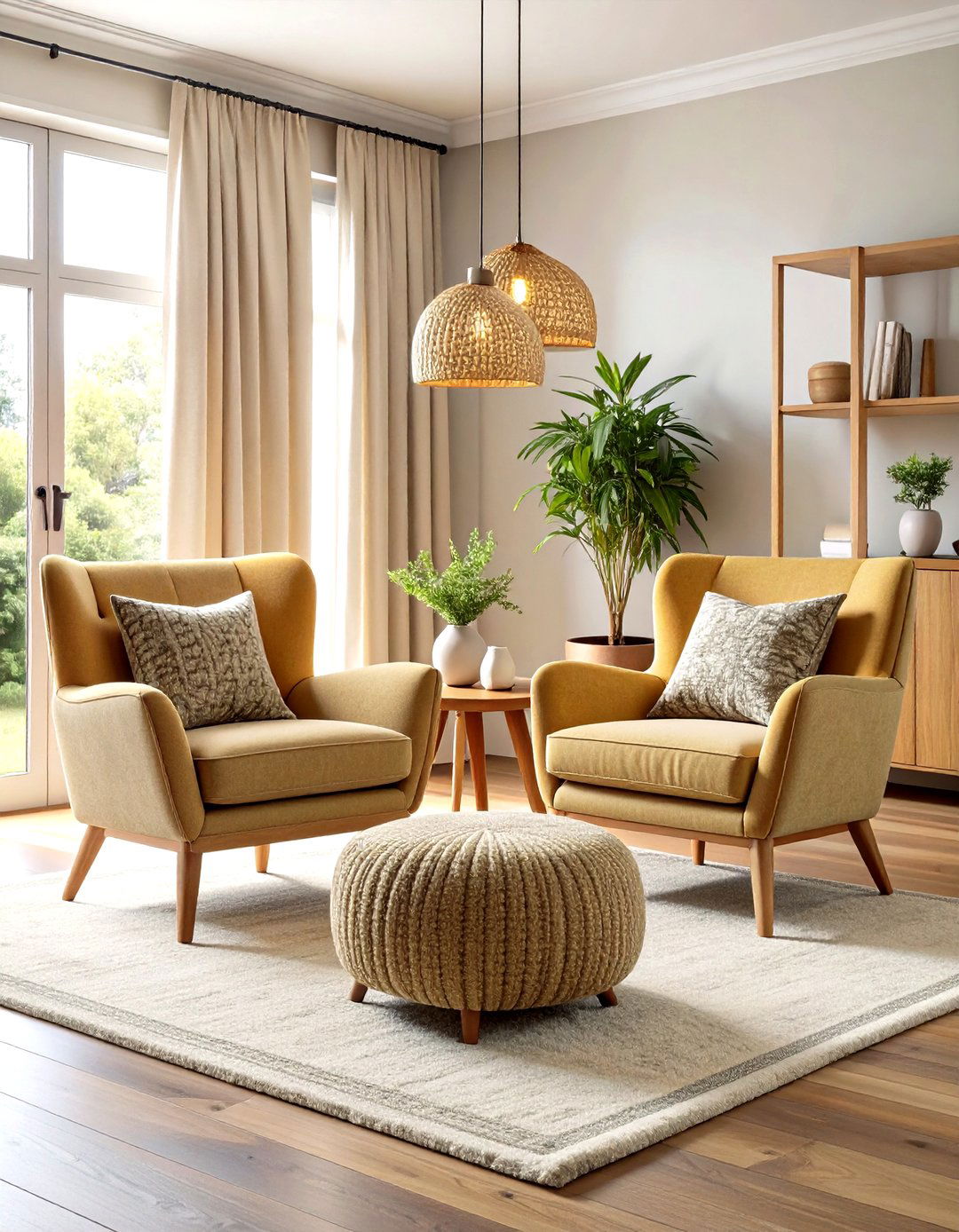
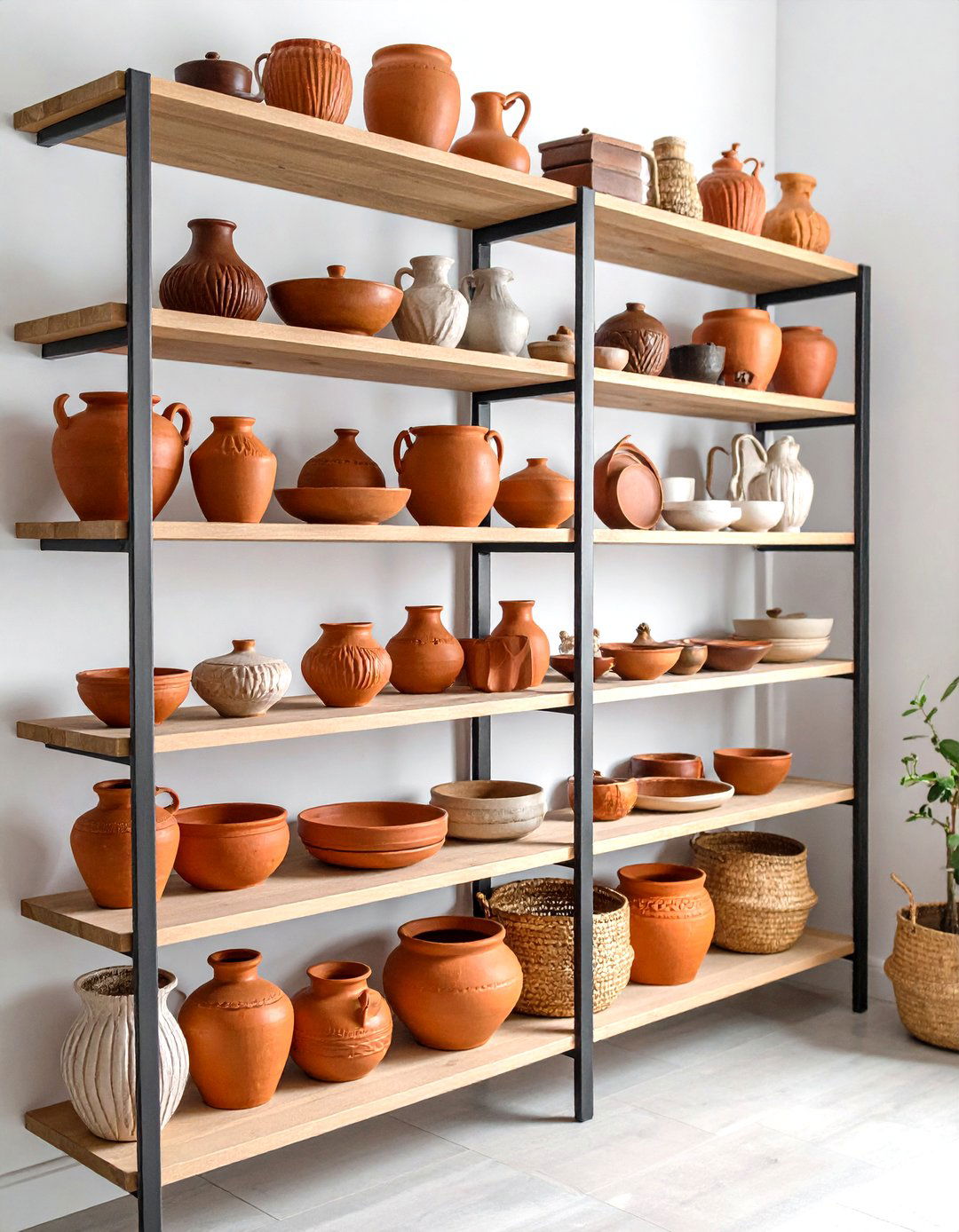
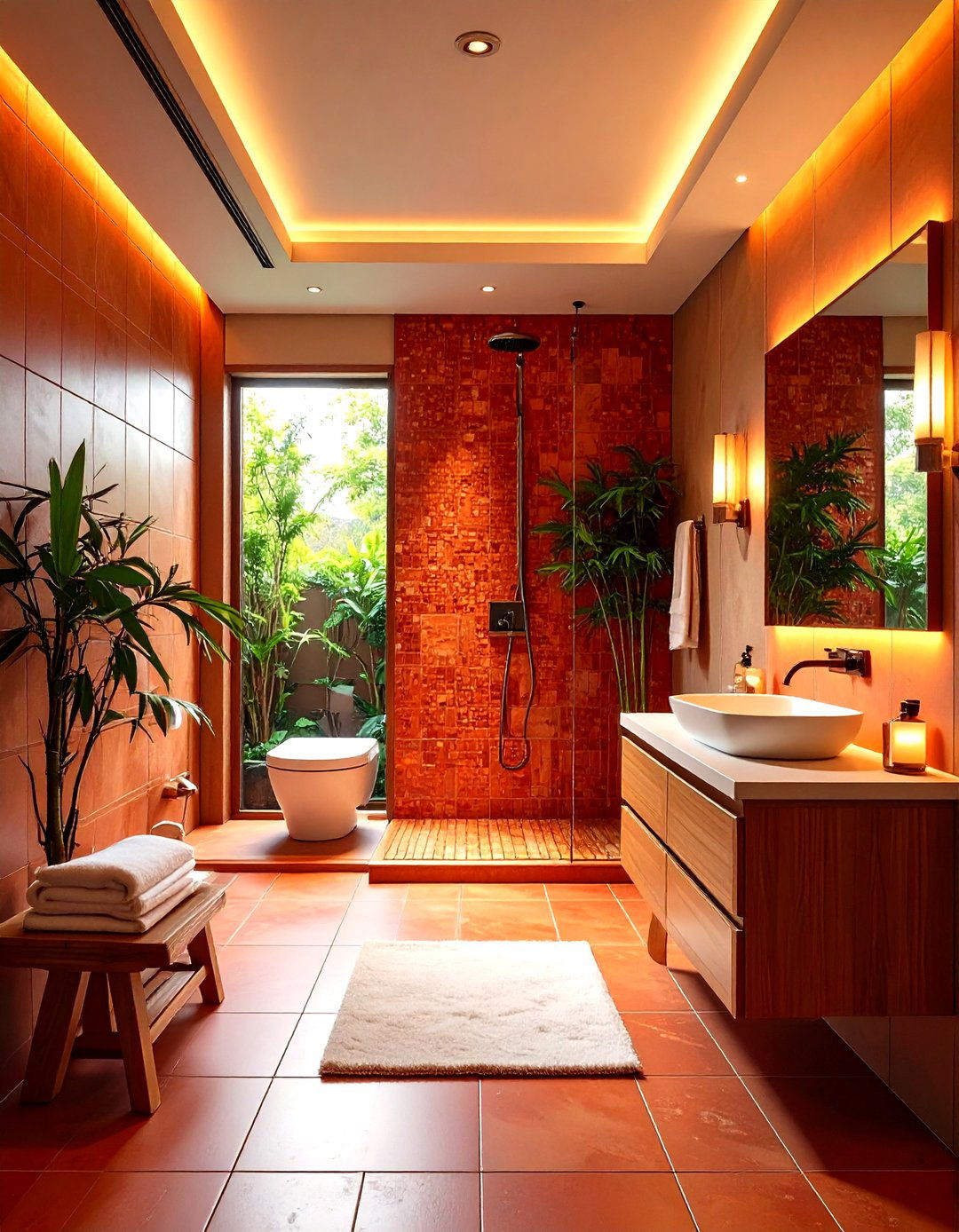
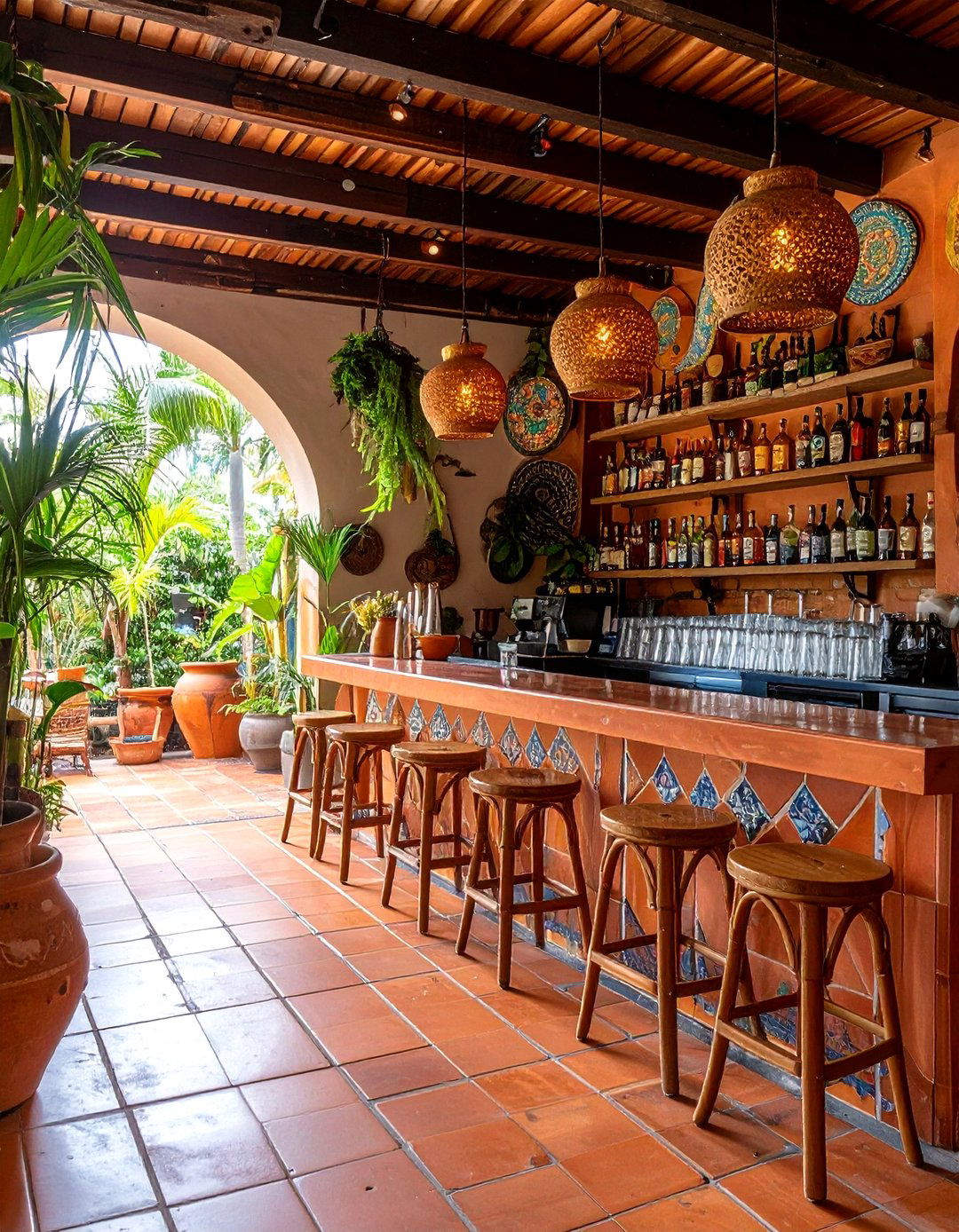

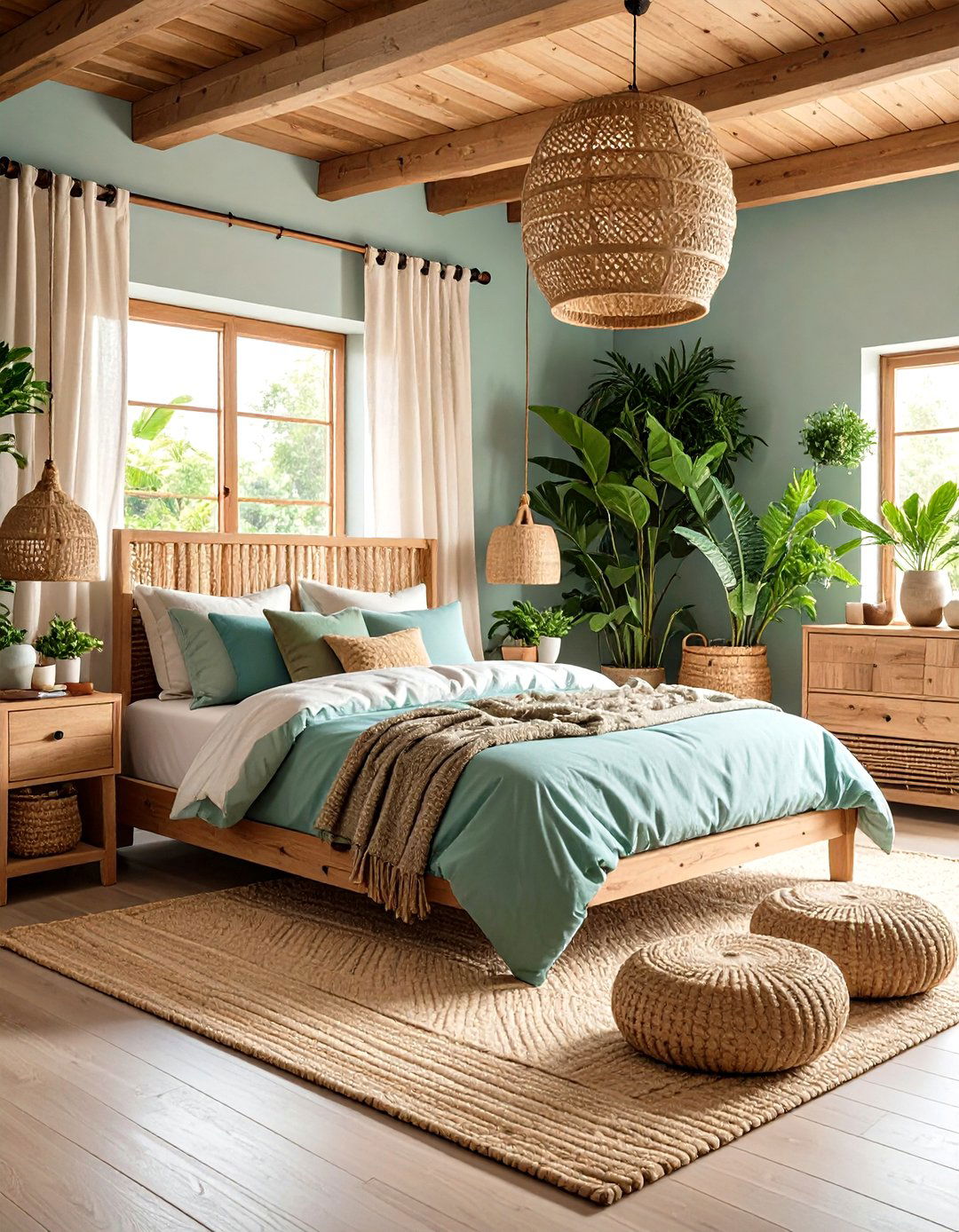
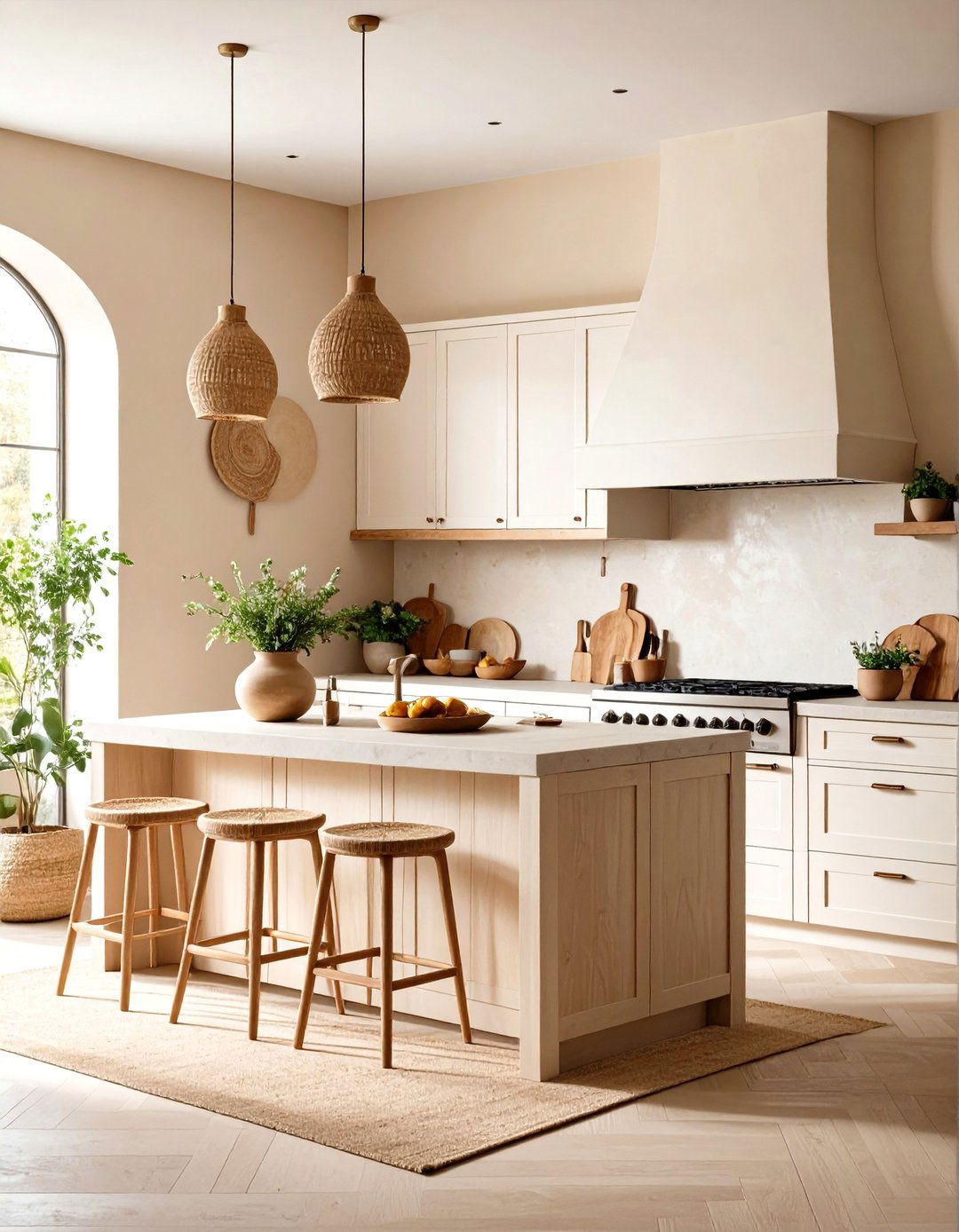
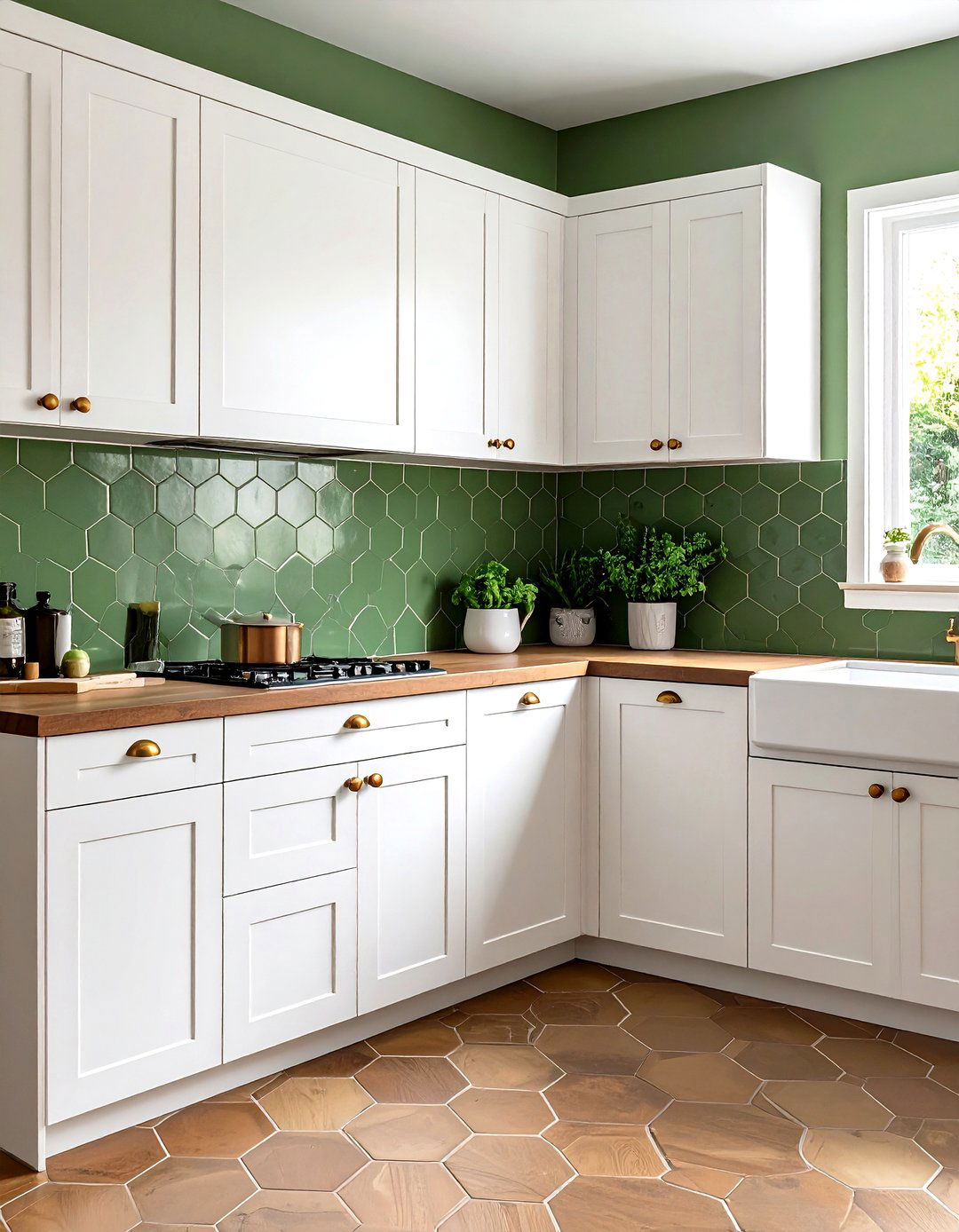
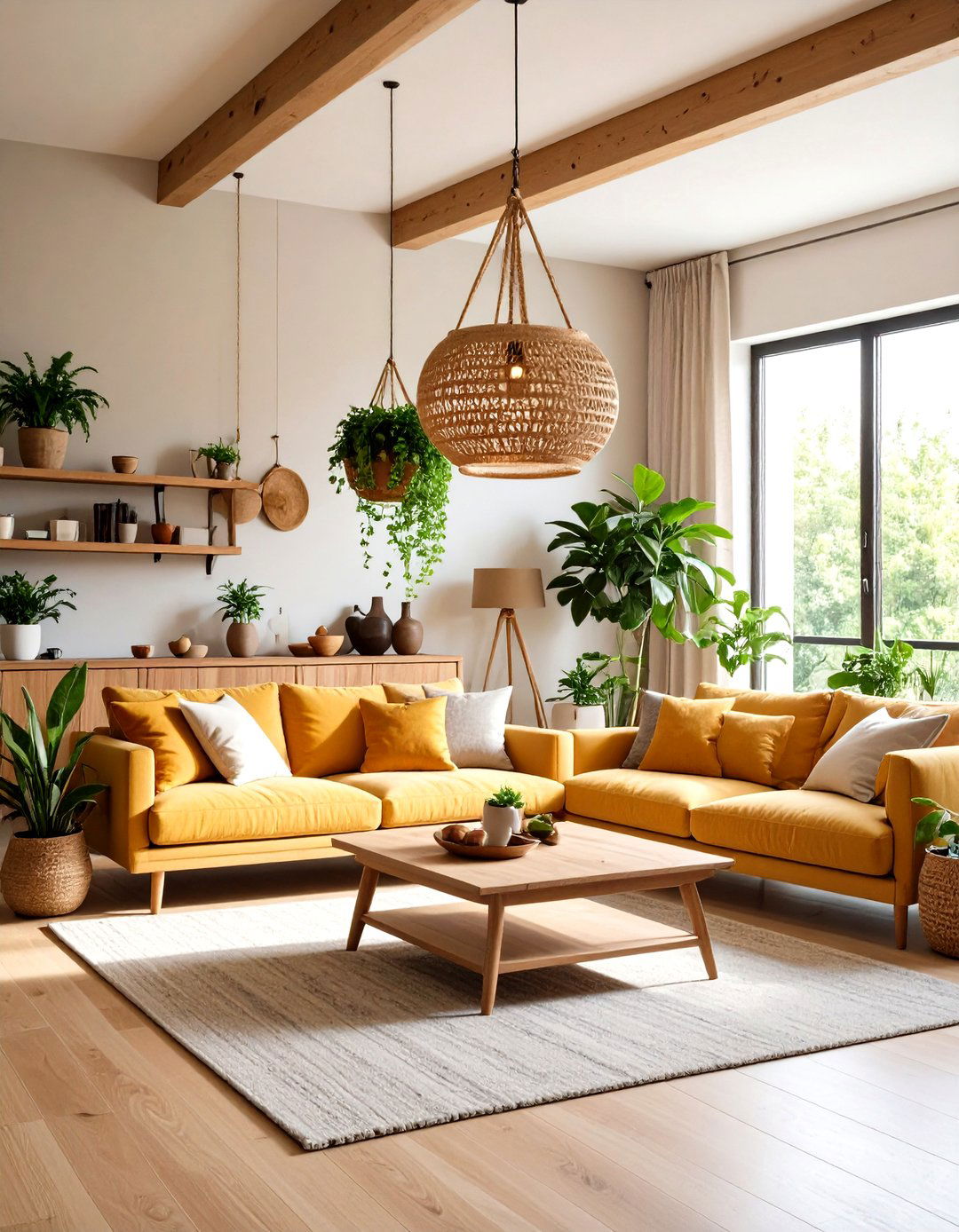
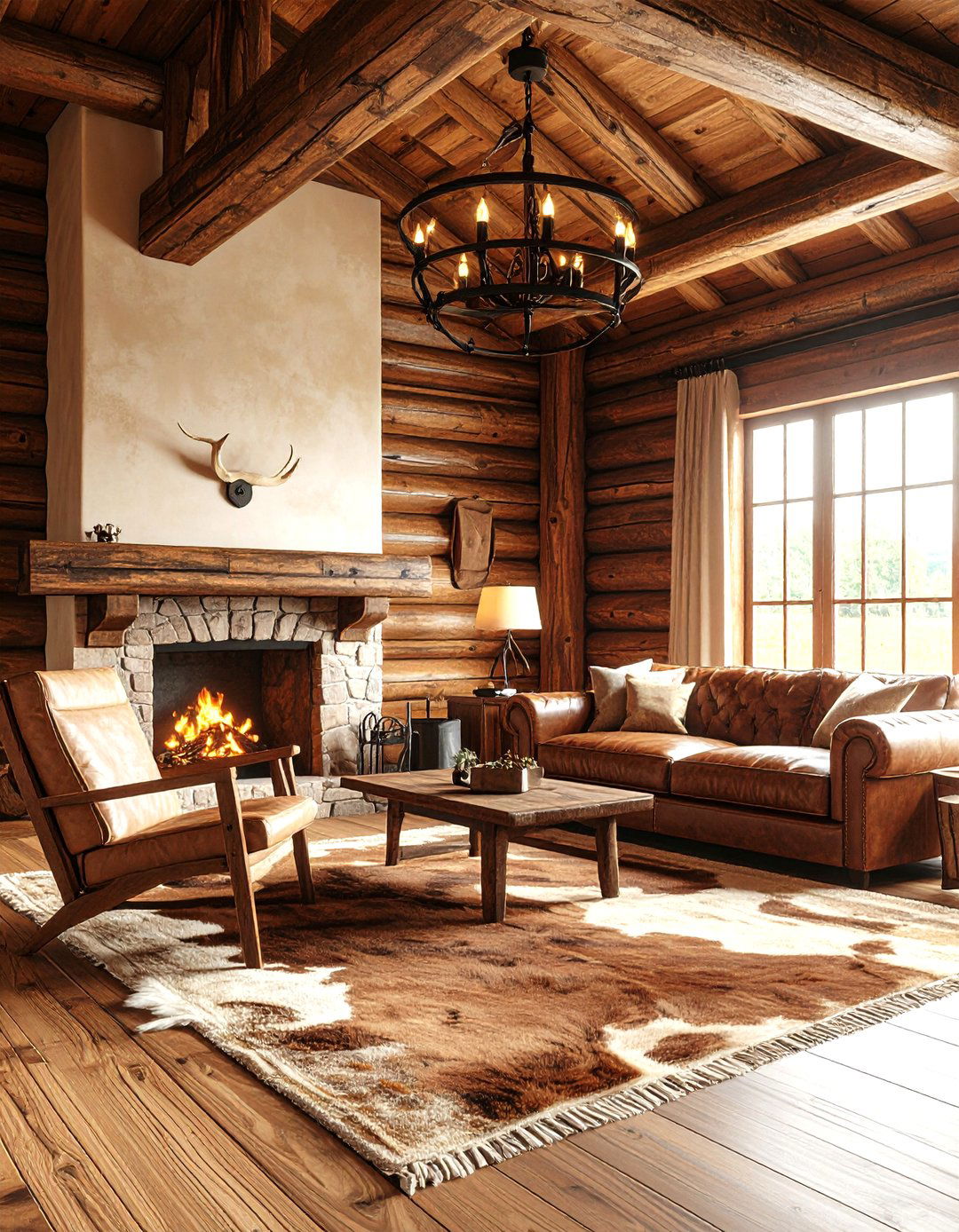
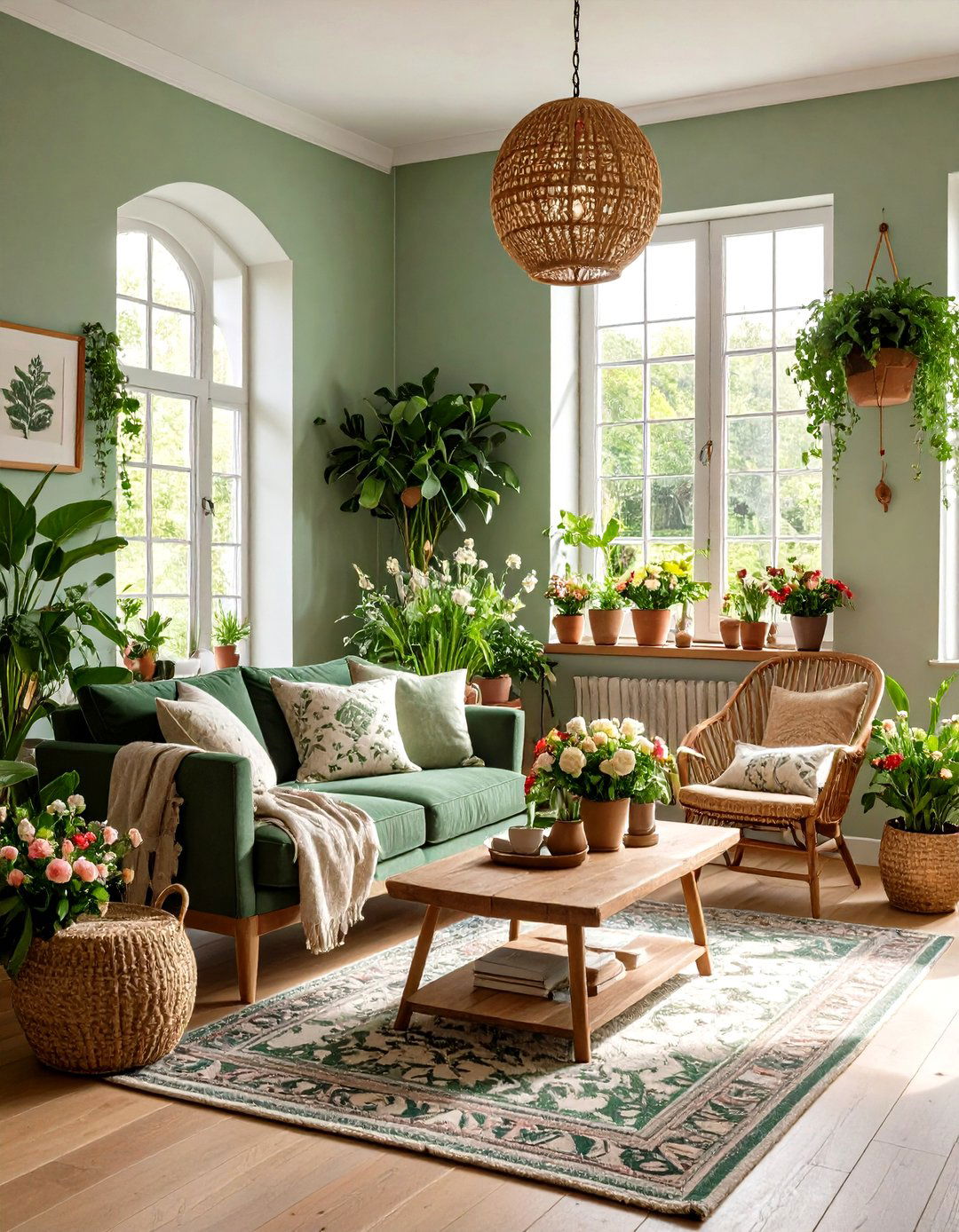
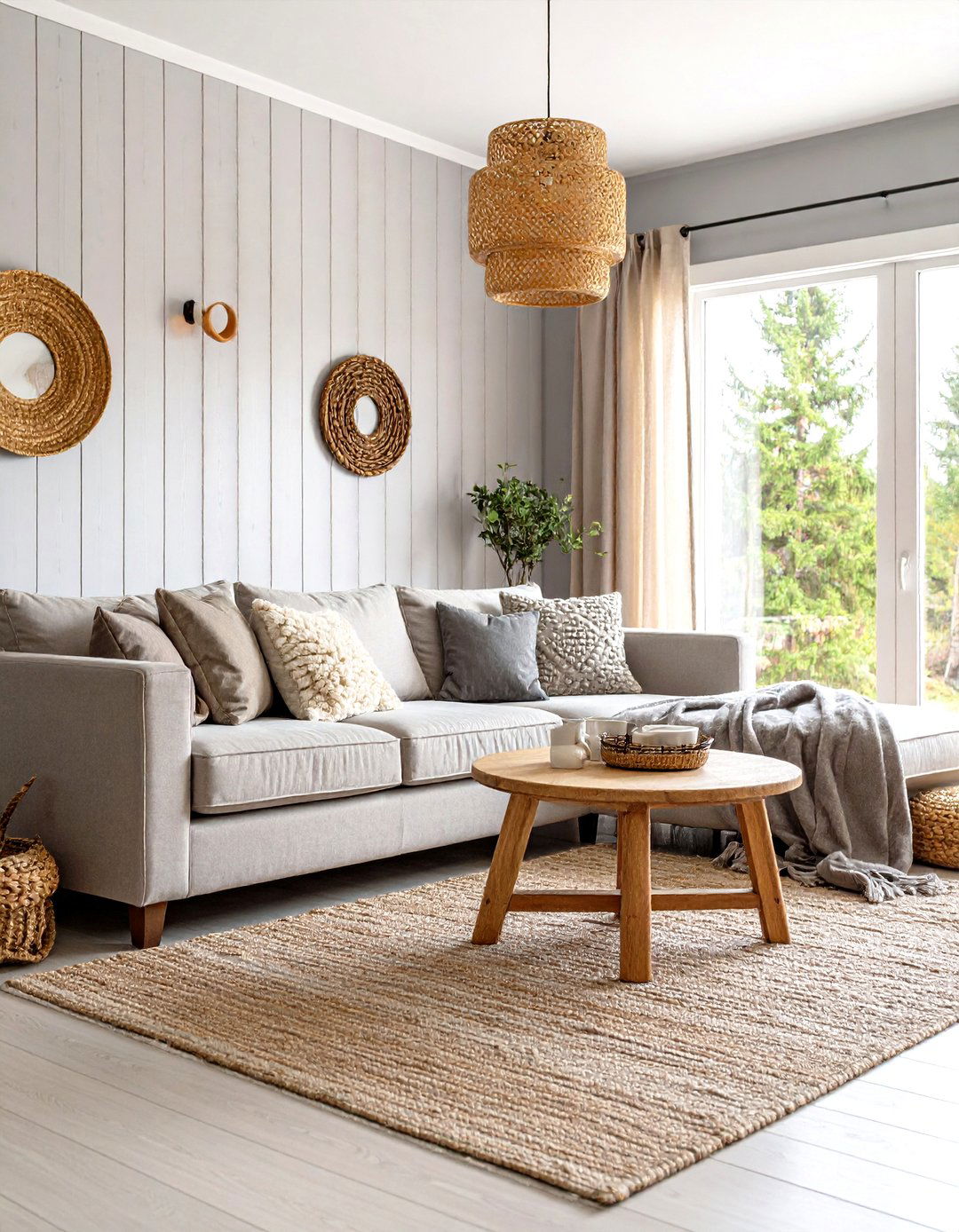
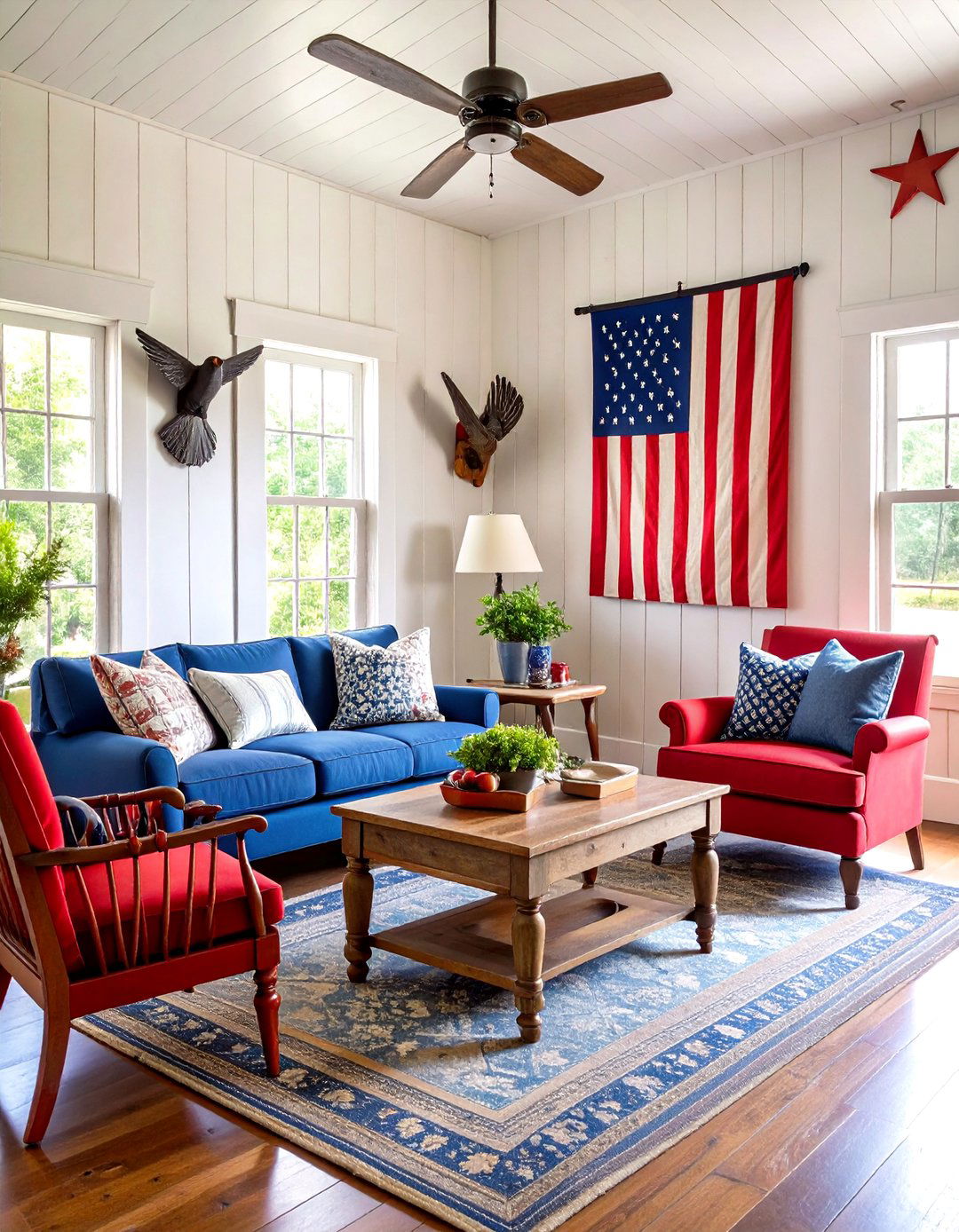
Leave a Reply